-
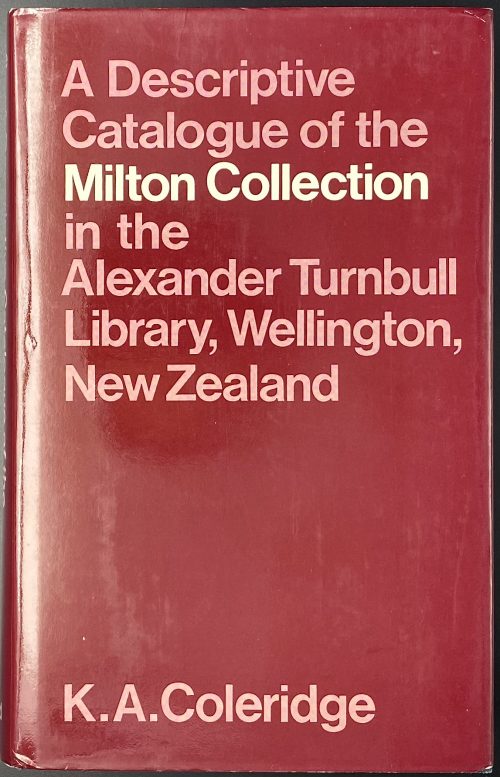 Title page: A DESCRIPTIVE CATALOGUE | OF THE | MILTON COLLECTION | IN THE ALEXANDER | TURNBULL LIBRARY, | WELLINGTON, | NEW ZEALAND |Describing works printed before 1801 | held in the Library at December 1975 | COMPILED BY | K. A. COLERIDGE | Published for the Alexander Turnbull Library, | National Library of New Zealand, | by OXFORD UNIVERSITY PRESS | 1980. Pagination: [i-v] vi-xxv [xxvi blank], [1] 2-536, plus 27 leaves with 60 plates. Printer: Printed in Great Britain at the Pitman Press, Bath. Size: 22.5 x 14.5 cm. Binding: Black cloth, gilt lettering to spine, lettered maroon dust-jacket, unclipped (£35.00 net in UK). Contributor: Kathleen A. Coleridge (New Zealand, b. 1944).
Title page: A DESCRIPTIVE CATALOGUE | OF THE | MILTON COLLECTION | IN THE ALEXANDER | TURNBULL LIBRARY, | WELLINGTON, | NEW ZEALAND |Describing works printed before 1801 | held in the Library at December 1975 | COMPILED BY | K. A. COLERIDGE | Published for the Alexander Turnbull Library, | National Library of New Zealand, | by OXFORD UNIVERSITY PRESS | 1980. Pagination: [i-v] vi-xxv [xxvi blank], [1] 2-536, plus 27 leaves with 60 plates. Printer: Printed in Great Britain at the Pitman Press, Bath. Size: 22.5 x 14.5 cm. Binding: Black cloth, gilt lettering to spine, lettered maroon dust-jacket, unclipped (£35.00 net in UK). Contributor: Kathleen A. Coleridge (New Zealand, b. 1944). -
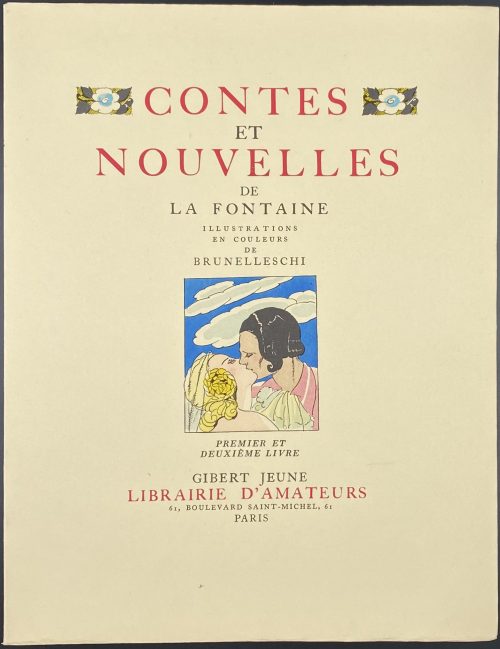 Vol. 1: Front wrapper and title page (in red and black): CONTES | ET | NOUVELLES | DE | LA FONTAINE | ILLUSTRATIONS | EN COULEURS | DE | BRUNELLESCHI | {vignette} | PREMIER ET DEUXIÈME LIVRE | GIBERT JEUNE | LIBRAIRIE D'AMATEURS | 61, BOULEVARD SAINT-MICHEL, 61 | PARIS || Pagination: [2] – blanks, [2] – h.t. / limit., [2] – t.p. / blank, [6] – advert., [2] – d.t.p., 1-164 [165-6], [4] – table, [2] – imprint / blank, [2] – blanks; total 188 pages (94 leaves) with 35 in-text black illustrations, plus 16 colour plates extraneous to collation, incl. frontispiece. Vol. 2: Front wrapper and title page similar to Vol. 1 but TROISIÈME, QUATRIÈME ET CINQUIÈME LIVRE under the vignette. Pagination: [2] – blanks, [2] – h.t. / limit., [2] – t.p. / blank, [2] – d.t.p., 1-233 [234], [4] – table, [2] – colophon / blank, [2] – blanks; total 250 pages (125 leaves) with 42 in-text black illustrations, plus 16 colour plates extraneous to collation, incl. frontispiece. Edition: Limited edition of 3,000 copies, this copy is № 1 (stamped in black in vol. 1). Printed on the 10th of June, 1938 by J. Dumoulin (H. Barthélemy – director, Louis Malexis – mise en page); stencil-colouring (au pochoir) by E. Charpentier under direction of the artist. Binding: Two volumes 26.3 x 20.3 cm, uniformly bound in publisher’s pictorial flapped wrappers with vignettes and lettering to front wrapper and spine and publisher’s device to back wrapper. Description of the stensil (au pochoir) technique.
Vol. 1: Front wrapper and title page (in red and black): CONTES | ET | NOUVELLES | DE | LA FONTAINE | ILLUSTRATIONS | EN COULEURS | DE | BRUNELLESCHI | {vignette} | PREMIER ET DEUXIÈME LIVRE | GIBERT JEUNE | LIBRAIRIE D'AMATEURS | 61, BOULEVARD SAINT-MICHEL, 61 | PARIS || Pagination: [2] – blanks, [2] – h.t. / limit., [2] – t.p. / blank, [6] – advert., [2] – d.t.p., 1-164 [165-6], [4] – table, [2] – imprint / blank, [2] – blanks; total 188 pages (94 leaves) with 35 in-text black illustrations, plus 16 colour plates extraneous to collation, incl. frontispiece. Vol. 2: Front wrapper and title page similar to Vol. 1 but TROISIÈME, QUATRIÈME ET CINQUIÈME LIVRE under the vignette. Pagination: [2] – blanks, [2] – h.t. / limit., [2] – t.p. / blank, [2] – d.t.p., 1-233 [234], [4] – table, [2] – colophon / blank, [2] – blanks; total 250 pages (125 leaves) with 42 in-text black illustrations, plus 16 colour plates extraneous to collation, incl. frontispiece. Edition: Limited edition of 3,000 copies, this copy is № 1 (stamped in black in vol. 1). Printed on the 10th of June, 1938 by J. Dumoulin (H. Barthélemy – director, Louis Malexis – mise en page); stencil-colouring (au pochoir) by E. Charpentier under direction of the artist. Binding: Two volumes 26.3 x 20.3 cm, uniformly bound in publisher’s pictorial flapped wrappers with vignettes and lettering to front wrapper and spine and publisher’s device to back wrapper. Description of the stensil (au pochoir) technique. -
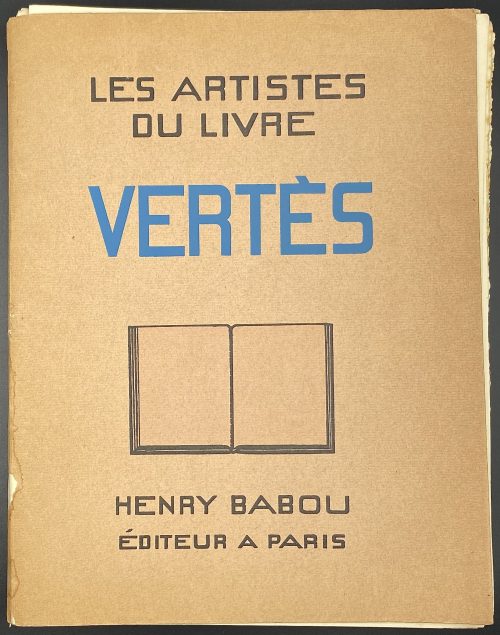 Title-page: LES ARTISTES DU LIVRE | MARCEL | VERTÈS | ÉTUDE PAR | ANDRÉ SALMON | LETTRE-PRÉFACE PAR | PAUL MORAND | PORTRAIT PAR | JEAN OBERLÉ | { publisher’s device} | HENRY BABOU, ÉDITEUR | 1, RUE VERNIQUET, PARIS | 1930 || Description: 26.3 x 20.5 cm, French flapped brown wrappers with black and blue lettering, lettering to spine, unbound, [1-2] 1st blank leaf, [3-4] h.t. / limitation, two plates (fac-simile letter and portrait of Vertès), [5-6] t.p. /”Cette monographie…”, 7-39 [40-48], incl. Bibliographie des ouvrages, Table des planches, and colophon – all with in-text illustrations; plus 22 leaves of plates, one on a double-page, all with foxing and marginal browning. Printing: December 1930 by Durcos & Colas in Paris. Edition: the 17th edition in the series “Les artistes du livre’, published under the direction of Marcel Valotaire; print run limited to 700 copies of which 50 on Japon (numbered 1-50) enriched with one original unpublished drypoint, 650 copies on Vélin Blanc from Arches (50-650), and 50 “non-commercial” copies (I-L). This copy is numbered № 473. Contributors: Marcel Vertès [Marcell Vértes] (Jewish-Hungarian-French, 1895 – 1961) – artist. André Salmon (French, 1881 – 1969) – author. Paul Morand (French, 1888 – 1976) – author. Jean Oberlé (French, 1900 – 1961) – artist. Maitres-imprimeurs Ducros et Colas (Paris) – printer. Henry Babou (Paris) – publisher. Marcel Valotaire (French, 1889 – 1979) – publisher. Other names: Marcel Vertès, Marcel Vertes, Marcell Vértes
Title-page: LES ARTISTES DU LIVRE | MARCEL | VERTÈS | ÉTUDE PAR | ANDRÉ SALMON | LETTRE-PRÉFACE PAR | PAUL MORAND | PORTRAIT PAR | JEAN OBERLÉ | { publisher’s device} | HENRY BABOU, ÉDITEUR | 1, RUE VERNIQUET, PARIS | 1930 || Description: 26.3 x 20.5 cm, French flapped brown wrappers with black and blue lettering, lettering to spine, unbound, [1-2] 1st blank leaf, [3-4] h.t. / limitation, two plates (fac-simile letter and portrait of Vertès), [5-6] t.p. /”Cette monographie…”, 7-39 [40-48], incl. Bibliographie des ouvrages, Table des planches, and colophon – all with in-text illustrations; plus 22 leaves of plates, one on a double-page, all with foxing and marginal browning. Printing: December 1930 by Durcos & Colas in Paris. Edition: the 17th edition in the series “Les artistes du livre’, published under the direction of Marcel Valotaire; print run limited to 700 copies of which 50 on Japon (numbered 1-50) enriched with one original unpublished drypoint, 650 copies on Vélin Blanc from Arches (50-650), and 50 “non-commercial” copies (I-L). This copy is numbered № 473. Contributors: Marcel Vertès [Marcell Vértes] (Jewish-Hungarian-French, 1895 – 1961) – artist. André Salmon (French, 1881 – 1969) – author. Paul Morand (French, 1888 – 1976) – author. Jean Oberlé (French, 1900 – 1961) – artist. Maitres-imprimeurs Ducros et Colas (Paris) – printer. Henry Babou (Paris) – publisher. Marcel Valotaire (French, 1889 – 1979) – publisher. Other names: Marcel Vertès, Marcel Vertes, Marcell Vértes -
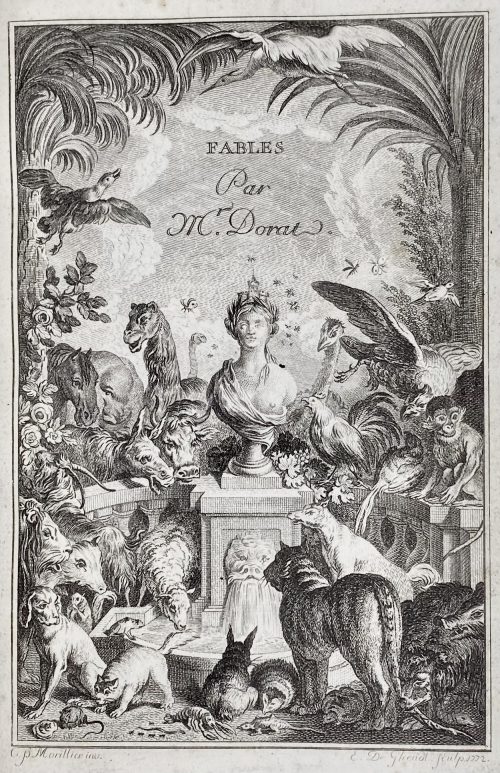 Title-page: FABLES | NOUVELLES. | {vignette by Ponce after Marillier} | A LA HAYE, | Et se trouve a Paris, | Chez Delalain, rue de la Comédie Françoise. | — | M. DCC. LXXIII. || Collation: 2 volumes (4 livres) in one, 1st blank, engraved t.p. “FABLES | Par | Mr. Dorat.” signed C. P. Marillier, inv. – E. D. Ghendt Sculp. 1772; a-c4, A-Z4 2A-2Q4, last blank, plus engraved frontispiece before A1 by Nicolas Delaunay and engraved d.t.p. before Z1: “Fables | de M. Dorat | II. Volume” also by Ghendt after Marillier., 99 vignettes and 99 tailpieces, all after Marillier. Lacking Delaunay frontispiece for the second volume (similar to the 1st). Edition: This is a vol. 1 176 pp. copy (Ray, 43). 2nd edition after Fables ou allégories philosophiques, 1772, p. 162 corrected: “Je sais , même au sein des poisons / Puiser le suc qui m'est utile”. Page xxii numbered correctly; on top of p. iii, printed a chain instead of a triple fillet in later issues (Ray, 43A). Pagination: [i, ii] iii-xxii, [2 d.t.p. «Livre premier»] [1] 2-309 [3 table], 3 plates. Binding: Crimson crashed morocco (198 x 133 mm) ruled in gilt, spine with raised bands gilt in compartments with gilt-lettered cream calf label, gilt dentelle inside, marbled endpapers, Pauli Menso bookplate pasted to front pastedown, printed on laid paper, AEG. Catalogue raisonné: Cohen-DeRicci: 313-315; Ray (French): № 43, pp. 81-83. Provenance: Pauli Menso. We only present a sample of illustrations, as their total number is enormous. Contributors: Author: Claude Joseph Dorat (French, 1734–1780) Publisher: Delalain (firm) (18th century) Artist: Clément Pierre Marillier (French, 1740–1808) Engravers: Jean Charles Baquoy (French, 1721–1777) Nicolas Delaunay (French, 1739–1792) Pierre Duflos (French, born in 1751) Emmanuel Jean Nepomucène de Ghendt (Flemish, worked in France, 1738–1815) Yves-Marie Le Gouaz (French, 1742–1816) Pierre Adrien Le Beau (French, 1748–after 1800) Jean-Jacques André Le Veau (French, 1729–1786) Charles Louis Lingée (French, 1748–1819) Joseph de Longueil (French, 1730–1792) Louis Legrand (French, 1723–1807) Jacques Le Roy (French, born in 1739) Louis Joseph Masquelier (French, 1741–1811) François Denis Née (French, 1735–1818) Nicholas Ponce (French, 1746–1831) Marguerite (Hémery) Ponce (French, born in 1745) Jean Baptiste Simonet (French, 1742–1813)
Title-page: FABLES | NOUVELLES. | {vignette by Ponce after Marillier} | A LA HAYE, | Et se trouve a Paris, | Chez Delalain, rue de la Comédie Françoise. | — | M. DCC. LXXIII. || Collation: 2 volumes (4 livres) in one, 1st blank, engraved t.p. “FABLES | Par | Mr. Dorat.” signed C. P. Marillier, inv. – E. D. Ghendt Sculp. 1772; a-c4, A-Z4 2A-2Q4, last blank, plus engraved frontispiece before A1 by Nicolas Delaunay and engraved d.t.p. before Z1: “Fables | de M. Dorat | II. Volume” also by Ghendt after Marillier., 99 vignettes and 99 tailpieces, all after Marillier. Lacking Delaunay frontispiece for the second volume (similar to the 1st). Edition: This is a vol. 1 176 pp. copy (Ray, 43). 2nd edition after Fables ou allégories philosophiques, 1772, p. 162 corrected: “Je sais , même au sein des poisons / Puiser le suc qui m'est utile”. Page xxii numbered correctly; on top of p. iii, printed a chain instead of a triple fillet in later issues (Ray, 43A). Pagination: [i, ii] iii-xxii, [2 d.t.p. «Livre premier»] [1] 2-309 [3 table], 3 plates. Binding: Crimson crashed morocco (198 x 133 mm) ruled in gilt, spine with raised bands gilt in compartments with gilt-lettered cream calf label, gilt dentelle inside, marbled endpapers, Pauli Menso bookplate pasted to front pastedown, printed on laid paper, AEG. Catalogue raisonné: Cohen-DeRicci: 313-315; Ray (French): № 43, pp. 81-83. Provenance: Pauli Menso. We only present a sample of illustrations, as their total number is enormous. Contributors: Author: Claude Joseph Dorat (French, 1734–1780) Publisher: Delalain (firm) (18th century) Artist: Clément Pierre Marillier (French, 1740–1808) Engravers: Jean Charles Baquoy (French, 1721–1777) Nicolas Delaunay (French, 1739–1792) Pierre Duflos (French, born in 1751) Emmanuel Jean Nepomucène de Ghendt (Flemish, worked in France, 1738–1815) Yves-Marie Le Gouaz (French, 1742–1816) Pierre Adrien Le Beau (French, 1748–after 1800) Jean-Jacques André Le Veau (French, 1729–1786) Charles Louis Lingée (French, 1748–1819) Joseph de Longueil (French, 1730–1792) Louis Legrand (French, 1723–1807) Jacques Le Roy (French, born in 1739) Louis Joseph Masquelier (French, 1741–1811) François Denis Née (French, 1735–1818) Nicholas Ponce (French, 1746–1831) Marguerite (Hémery) Ponce (French, born in 1745) Jean Baptiste Simonet (French, 1742–1813) -
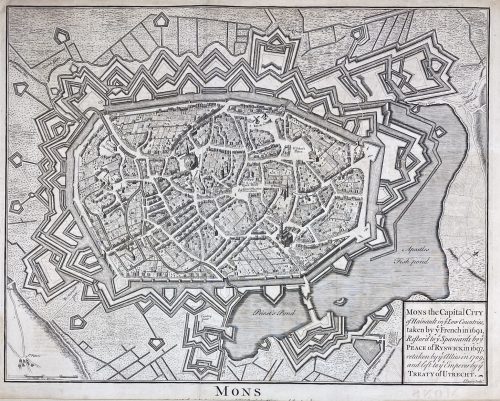
Mons the Capital City of Hainault in y Low Countries, taken by y French in 1691, Restor'd to y Spaniards by y Peace of Ryswick in 1697, retaken by y Allies in 1709, and left to y Emperor by y Treaty of Utrecht. attribution to publication source has been trimmed.
Dimensions: Sheet: 40.7 x 52.5 cm; Image: 37.5 x 48 cm. Published between 1744 and 1747. Attribution to publication source has been trimmed. Reference: Royal Academy 03/2919. Source: Maps for Mr. Tindal's Continuation of Mr. Rapin's History of England. London: John and Paul Knapton. Nicolas Tindal (British, 1687 – 1774) – the translator and continuer of the History of England by Paul de Rapin. Paul de Rapin (French, 1661 – 1725) – a Huguenot historian, author of the History of England. -
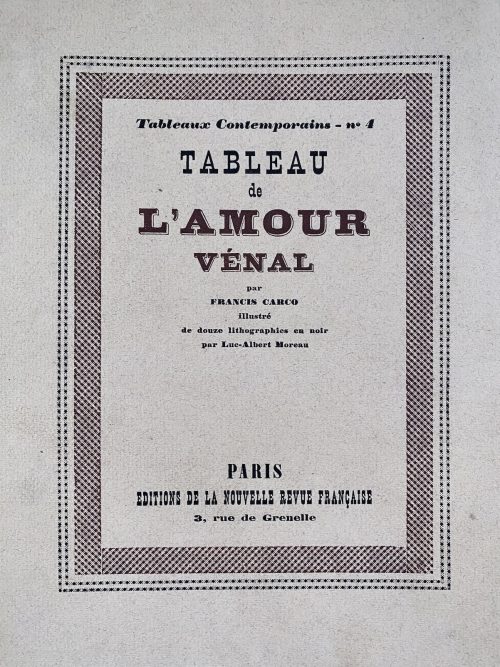 Description: Softcover, French flapped wrappers, lettered front, back (advert.) and spine, collated in-4to, 24.3 x 20.2 cm, printed on thick wove paper Vélin pur fil Lafuma-Navarre, print run limited to 335 copies from which this is copy № 219; outer margin untrimmed, some leaves uncut, glassine DJ. Limitation: 1 copy (A) on Japon Impérial + double suite of plates + suite of original drawings, 4 copies (B-E) on Japon Impérial + double suite of plates, 15 copies on on Japon Impérial + suite of plates on Vieux Japon teinté (F-T), 315 copies on Vélin pur fil Lafuma-Navarre, of which 15 (I-XV) not for sale. Copyright: Libraire Gallimard, 1924. Printed: March 10, 1924 – text by Coulouma (Argenteuil) under direction of H. Barthélemy, lithographs printed by Marchizet (Paris). Front wrapper (in letterpress two-colour border): Tableaux Contemporains – no 4 | . TABLEAU | de | L'AMOUR | VÉNAL | par | FRANCIS CARCO | Illustré | de douze lithographies en noir | par Luc-Albert Moreau | PARIS | ÉDITIONS DE LA NOUVELLE REVUE FRANÇAISE | 3, rue de Grenelle || Title-page: Same, without a frame, in black, L'AMOUR | VÉNAL in brown. Collation: 4to; 14 a4 2-164, total 68 leaves with wrappers included in collation plus 12 plates, incl. frontispiece, extraneous to collation. Pagination: [2 wrapper] [6] [i] ii-vii [viii blank] [9] 10-122 [2 colophon] [2 blank] [2 wrapper]; total 136 pages incl. wrappers, plus ils. Contributors: Francis Carco [François Carcopino-Tusoli] (French, 1886 – 1958) – author. Luc-Albert Moreau (French, 1882 – 1948) – artist. La Nouvelle Revue Française (nrf) (Paris)– publisher. Gaston Gallimard (French, 1881 – 1975) – publisher.
Description: Softcover, French flapped wrappers, lettered front, back (advert.) and spine, collated in-4to, 24.3 x 20.2 cm, printed on thick wove paper Vélin pur fil Lafuma-Navarre, print run limited to 335 copies from which this is copy № 219; outer margin untrimmed, some leaves uncut, glassine DJ. Limitation: 1 copy (A) on Japon Impérial + double suite of plates + suite of original drawings, 4 copies (B-E) on Japon Impérial + double suite of plates, 15 copies on on Japon Impérial + suite of plates on Vieux Japon teinté (F-T), 315 copies on Vélin pur fil Lafuma-Navarre, of which 15 (I-XV) not for sale. Copyright: Libraire Gallimard, 1924. Printed: March 10, 1924 – text by Coulouma (Argenteuil) under direction of H. Barthélemy, lithographs printed by Marchizet (Paris). Front wrapper (in letterpress two-colour border): Tableaux Contemporains – no 4 | . TABLEAU | de | L'AMOUR | VÉNAL | par | FRANCIS CARCO | Illustré | de douze lithographies en noir | par Luc-Albert Moreau | PARIS | ÉDITIONS DE LA NOUVELLE REVUE FRANÇAISE | 3, rue de Grenelle || Title-page: Same, without a frame, in black, L'AMOUR | VÉNAL in brown. Collation: 4to; 14 a4 2-164, total 68 leaves with wrappers included in collation plus 12 plates, incl. frontispiece, extraneous to collation. Pagination: [2 wrapper] [6] [i] ii-vii [viii blank] [9] 10-122 [2 colophon] [2 blank] [2 wrapper]; total 136 pages incl. wrappers, plus ils. Contributors: Francis Carco [François Carcopino-Tusoli] (French, 1886 – 1958) – author. Luc-Albert Moreau (French, 1882 – 1948) – artist. La Nouvelle Revue Française (nrf) (Paris)– publisher. Gaston Gallimard (French, 1881 – 1975) – publisher. -
 Kominato in Awa province [Awa Kominato] – one of five fan prints in the series Famous places in the Bōsō peninsula [Bōsō meisho], devoted to the trip undertaken by Hiroshige in 1852 to Bōsō peninsula (present-day Chiba prefecture). “Two fashionably dressed women beside the veranda of a wayside inn gaze out over Uchiura Bay toward the Tanjō Temple on the far shore, as a boat sets out to the sea from the fishing hamlet of Kominato. …Hiroshige’s viewpoint is from the lower slopes of Mount Kiyosumi”. Ref: Sebastian Izzard. Important Japanese Prints 1830–1860 March 14–20, 2020 exhibition [LIB-2398.2020], №. 52. Not in Faulkner's Hiroshige Fan Prints. Artist: Utagawa Hiroshige [歌川 広重] a.k.a. Andō Hiroshige [安藤 広重] (Japanese, 1797 – 1858). Publisher: Tsujiya Yasubei [辻屋安兵衛] Kinkaido [錦魁堂] (Japanese, c. 1842 – 1863) Date seal and double nanushi censor seal: Mera & Watanabe; Kaei 5, 11th month (1852). Signed: Hiroshige ga [広重 画] in a red cartouche. Size: Fan print (Aiban yoko-e uchiwa-e); 225 x 292 mm.
Kominato in Awa province [Awa Kominato] – one of five fan prints in the series Famous places in the Bōsō peninsula [Bōsō meisho], devoted to the trip undertaken by Hiroshige in 1852 to Bōsō peninsula (present-day Chiba prefecture). “Two fashionably dressed women beside the veranda of a wayside inn gaze out over Uchiura Bay toward the Tanjō Temple on the far shore, as a boat sets out to the sea from the fishing hamlet of Kominato. …Hiroshige’s viewpoint is from the lower slopes of Mount Kiyosumi”. Ref: Sebastian Izzard. Important Japanese Prints 1830–1860 March 14–20, 2020 exhibition [LIB-2398.2020], №. 52. Not in Faulkner's Hiroshige Fan Prints. Artist: Utagawa Hiroshige [歌川 広重] a.k.a. Andō Hiroshige [安藤 広重] (Japanese, 1797 – 1858). Publisher: Tsujiya Yasubei [辻屋安兵衛] Kinkaido [錦魁堂] (Japanese, c. 1842 – 1863) Date seal and double nanushi censor seal: Mera & Watanabe; Kaei 5, 11th month (1852). Signed: Hiroshige ga [広重 画] in a red cartouche. Size: Fan print (Aiban yoko-e uchiwa-e); 225 x 292 mm. -
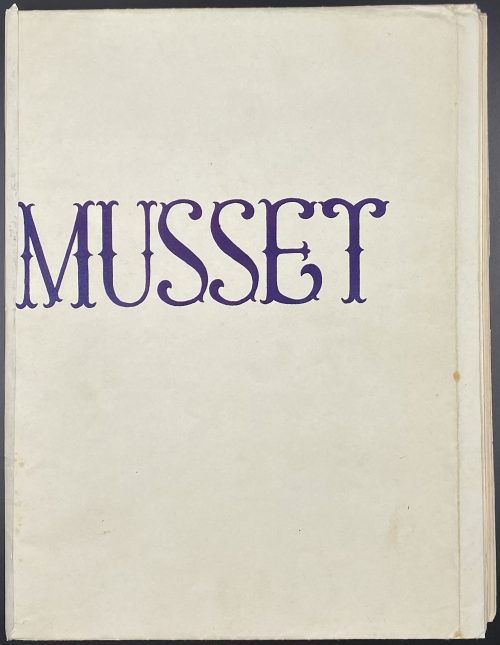 Description: one volume in French flapped wrappers 25.3 x 19 cm, lettered “MUSSET” to front, 5 gatherings of 4 and one of 6 leaves, 26 leaves total, pp.: [4] [2] 3-43 [44] [4], total 52 pages, incl. those in wrappers, unbound; plus coloured and uncoloured suites of 12 lithographs, in a paper folder; in a cardboard tan slipcase 2.8 x 19.3 cm. Artist unknown, publisher unknown, published at the end of 1940s (per J.-P. Dutel). Illustrations are a loose interpretation of original lithographs by Devéria and Henri Grévedon or Octave Tassaert for the 1833 edition ((1926 re-print LIB-3135.2023). Limitation: Edition limited to 250 copies printed on Vélin Chiffon numbered 1 -250 and 24 copies marked by letters A to Z. This is copy № 246, with two suites of plates, one coloured and one b/w. Catalogue raisonné: Dutel (1920-1970) № 1657, p. 189. Alfred de Musset (French, 1810 – 1857) – author.
Description: one volume in French flapped wrappers 25.3 x 19 cm, lettered “MUSSET” to front, 5 gatherings of 4 and one of 6 leaves, 26 leaves total, pp.: [4] [2] 3-43 [44] [4], total 52 pages, incl. those in wrappers, unbound; plus coloured and uncoloured suites of 12 lithographs, in a paper folder; in a cardboard tan slipcase 2.8 x 19.3 cm. Artist unknown, publisher unknown, published at the end of 1940s (per J.-P. Dutel). Illustrations are a loose interpretation of original lithographs by Devéria and Henri Grévedon or Octave Tassaert for the 1833 edition ((1926 re-print LIB-3135.2023). Limitation: Edition limited to 250 copies printed on Vélin Chiffon numbered 1 -250 and 24 copies marked by letters A to Z. This is copy № 246, with two suites of plates, one coloured and one b/w. Catalogue raisonné: Dutel (1920-1970) № 1657, p. 189. Alfred de Musset (French, 1810 – 1857) – author. -
 Artist (attributed, no signature): Suzuki Harunobu [鈴木 春信] (Japanese, c. 1725 – 1770). The title is taken from [LIB-1478.2013] Gian Carlo Calza, Stefania Piotti. Poem of the pillow and other stories. — Phaidon Press, 2010; pp. 148-9. Alternative title: Man sucking woman's breast and a cat sitting under a bonsai tree. The open book beside the couple reads 子春 (Koharu). Woodblock print from the series Mirror Picture of Japan (Wakoku kagami); Size: Horizontal chuban; 21 x 26 cm.
Artist (attributed, no signature): Suzuki Harunobu [鈴木 春信] (Japanese, c. 1725 – 1770). The title is taken from [LIB-1478.2013] Gian Carlo Calza, Stefania Piotti. Poem of the pillow and other stories. — Phaidon Press, 2010; pp. 148-9. Alternative title: Man sucking woman's breast and a cat sitting under a bonsai tree. The open book beside the couple reads 子春 (Koharu). Woodblock print from the series Mirror Picture of Japan (Wakoku kagami); Size: Horizontal chuban; 21 x 26 cm. -
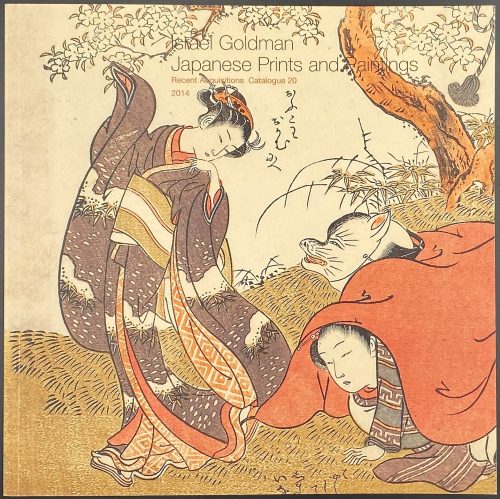 Softcover, pictorial wrappers, square 21 x 21 cm, 40 leaves, unpaginated, with illustrations in colour, 77 entries, with price list laid in; limited edition of 700 copies. Contributor: Israel Goldman Prints in this collection:
Softcover, pictorial wrappers, square 21 x 21 cm, 40 leaves, unpaginated, with illustrations in colour, 77 entries, with price list laid in; limited edition of 700 copies. Contributor: Israel Goldman Prints in this collection:![Isoda Koryūsai . Prosperous Flowers of the Elegant Twelve Seasons: young couple making love while older man sleeps. [Shunga]. 1773](http://varshavskycollection.com/wp-content/uploads/2020/12/SVJP200039.2015-400x288.jpeg)
SVJP-0039.2015: Isoda Koryūsai. Kikuzuki (the ninth month) from the series Furyu juniki no eiga (Prosperous flowers of the elegant twelve months) / Chuban, early 1770s; #7 in the catalogue.
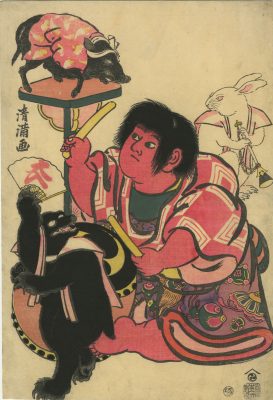
SVJP-0180.2014: Torii Kiyomitsu II. Kintaro with a boar, rabbit, and tanuki / Oban, c. 1805; # 15 in the catalogue.
-
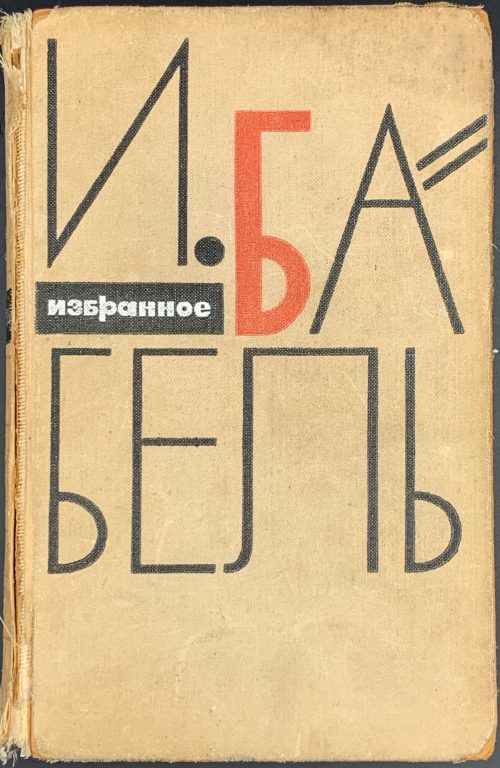 Description: one volume, 20.7 x 13.3 cm, bound in cream cloth with red and black lettering to front cover and spine, author’s photographic portrait frontispiece. Title-page (black and red): ИЗБРАННОЕ (vertical, red) | И. БАБЕЛЬ | {publisher’s device “ИХЛ”} | Издательство | «ХУДОЖЕСТВЕННАЯ ЛИТЕРАТУРА» | Москва | 1966 || Contents: Конармия; Одесские рассказы; Рассказы; Воспоминания; Пьесы; Статьи, выступления; Письма; Комментарии. Imprint: Вступительная статья | Л. ПОЛЯК | Комментарии | Е. КРАСНОЩЕКОВОЙ | Оформление художника | Ю. БОЯРСКОГО | 7–3–2 / 57–66 || Pagination :[2] 3-493 [494] [2]; total 496 pages, ils. Collation: 8vo; [1]-318; total 248 leaves plus author’s photographic portrait frontispiece. Contributors: Исаак Эммануилович Бабель [Isaac Babel] (Russian-Jewish, 1894 – 1940) – author. Лидия Моисеевна Поляк (Russian-Jewish, 1899 – 1992) – author, foreword. Елена Александровна Краснощекова (Russian-Jewish, b. 1934) (see Александр Михайлович Краснощёков) – author, commentary. Юлий Александрович Боярский (Russian, 1924 – 2009) – artist.
Description: one volume, 20.7 x 13.3 cm, bound in cream cloth with red and black lettering to front cover and spine, author’s photographic portrait frontispiece. Title-page (black and red): ИЗБРАННОЕ (vertical, red) | И. БАБЕЛЬ | {publisher’s device “ИХЛ”} | Издательство | «ХУДОЖЕСТВЕННАЯ ЛИТЕРАТУРА» | Москва | 1966 || Contents: Конармия; Одесские рассказы; Рассказы; Воспоминания; Пьесы; Статьи, выступления; Письма; Комментарии. Imprint: Вступительная статья | Л. ПОЛЯК | Комментарии | Е. КРАСНОЩЕКОВОЙ | Оформление художника | Ю. БОЯРСКОГО | 7–3–2 / 57–66 || Pagination :[2] 3-493 [494] [2]; total 496 pages, ils. Collation: 8vo; [1]-318; total 248 leaves plus author’s photographic portrait frontispiece. Contributors: Исаак Эммануилович Бабель [Isaac Babel] (Russian-Jewish, 1894 – 1940) – author. Лидия Моисеевна Поляк (Russian-Jewish, 1899 – 1992) – author, foreword. Елена Александровна Краснощекова (Russian-Jewish, b. 1934) (see Александр Михайлович Краснощёков) – author, commentary. Юлий Александрович Боярский (Russian, 1924 – 2009) – artist. -
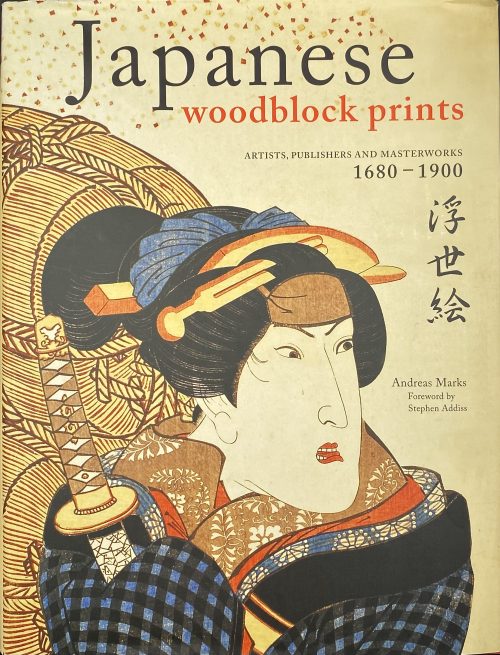 Hardcover, 31 x 24 cm, red paper with black and white lettering to front cover and spine, pictorial endpapers, pictorial dust jacket; pp.: [1-8] 9-336, profusely illustrated in colour. Title-page (black and red): Japanese | woodblock prints | ARTISTS, PUBLISHERS AND MASTERWORKS | 1680 – 1900 | Andreas Marks {|} Foreword by Stephen Addiss | TUTTLE PUBLISHING | Tokyo • Rutland, Vermont • Singapore ||
Hardcover, 31 x 24 cm, red paper with black and white lettering to front cover and spine, pictorial endpapers, pictorial dust jacket; pp.: [1-8] 9-336, profusely illustrated in colour. Title-page (black and red): Japanese | woodblock prints | ARTISTS, PUBLISHERS AND MASTERWORKS | 1680 – 1900 | Andreas Marks {|} Foreword by Stephen Addiss | TUTTLE PUBLISHING | Tokyo • Rutland, Vermont • Singapore || -
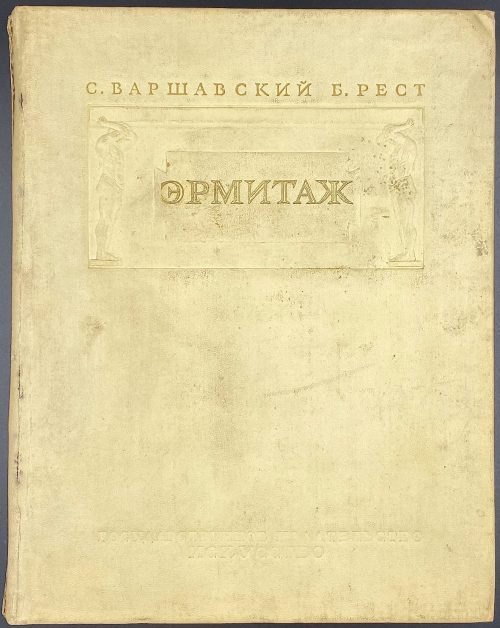 A book about the history and collections of The Hermitage museum in St. Petersburg; hardcover, 22 x 17 cm, collated 8vo, cream buckram blind stamped and lettered in gilt to front cover and design elements and lettering to spine, profusely illustrated. Title-page (in brown rules): С. ВАРШАВСКИЙ • Б. РЕСТ | ЭРМИТАЖ | 1764 – 1939 | ОЧЕРКИ ИЗ ИСТОРИИ | ГОСУДАРСТВЕННОГО ЭРМИТАЖА | под редакцией | академика | И. А. Орбели | {fleuron} || Collation: π2 [1]-158 166; total 128 leaves. Pagination: [2] [2] i-ii [1-4] 5-250 [2], total 256 pages, in-text b/w illustrations. Print run: 5,000 copies. Joseph Orbeli [Иосиф Абгарович Орбели] (Russian-Armenian, 1887 – 1961) – editor. Sergei Petrovich Varshavsky [Сергей Петрович Варшавский] (Jewish-Russian, 1906 – 1980). B. Rest [Б. Рест; Юлий Исаакович Шапиро] (Jewish-Russian, fl. 1940 – 1980).
A book about the history and collections of The Hermitage museum in St. Petersburg; hardcover, 22 x 17 cm, collated 8vo, cream buckram blind stamped and lettered in gilt to front cover and design elements and lettering to spine, profusely illustrated. Title-page (in brown rules): С. ВАРШАВСКИЙ • Б. РЕСТ | ЭРМИТАЖ | 1764 – 1939 | ОЧЕРКИ ИЗ ИСТОРИИ | ГОСУДАРСТВЕННОГО ЭРМИТАЖА | под редакцией | академика | И. А. Орбели | {fleuron} || Collation: π2 [1]-158 166; total 128 leaves. Pagination: [2] [2] i-ii [1-4] 5-250 [2], total 256 pages, in-text b/w illustrations. Print run: 5,000 copies. Joseph Orbeli [Иосиф Абгарович Орбели] (Russian-Armenian, 1887 – 1961) – editor. Sergei Petrovich Varshavsky [Сергей Петрович Варшавский] (Jewish-Russian, 1906 – 1980). B. Rest [Б. Рест; Юлий Исаакович Шапиро] (Jewish-Russian, fl. 1940 – 1980). -
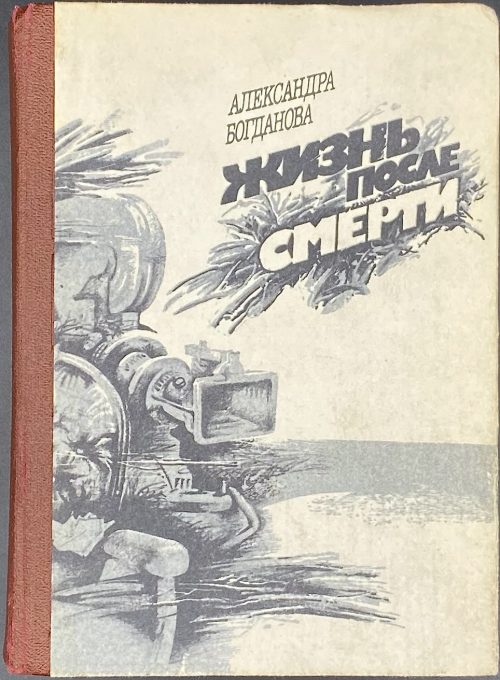 Hardcover, 17.2 x 12.5 cm, brown cloth-backed pictorial paper boards, lettering to front and spine, pictorial endpapers, pp.: [1-4] 5-430 [2], total 432 pages; collated in-16mo: [1]-1216 138 1416, total 216 leaves. Print run: 65,000 copies. A real history-based fiction about doctor Nikolai Sudzilovsky [Nicholas Russel] (Belarusian, 1850 – 1930). Title-page (pictorial): АЛЕКСАНДРА | БОГДАНОВА | ЖИЗНЬ | ПОСЛЕ | СМЕРТИ | Роман || Imprint: Рецензент доктор филилогических наук Н. Г. Жулинский. Редактор В. А. Лигостов. Богданова А. И. Жизнь после смерти: Роман. — К.: Рад. письменник, 1990. — 431 с. ISBN 5-333-00201-0. Colophon: Литературно-художественное издание. БОГДАНОВА АЛЕКСАНДРА ИВАНОВНА | Жизнь после смерти. Роман. Киев, издательство «Радяньский пысьмэннык». Author: Богданова, Александра Ивановна (b. c. 1950).
Hardcover, 17.2 x 12.5 cm, brown cloth-backed pictorial paper boards, lettering to front and spine, pictorial endpapers, pp.: [1-4] 5-430 [2], total 432 pages; collated in-16mo: [1]-1216 138 1416, total 216 leaves. Print run: 65,000 copies. A real history-based fiction about doctor Nikolai Sudzilovsky [Nicholas Russel] (Belarusian, 1850 – 1930). Title-page (pictorial): АЛЕКСАНДРА | БОГДАНОВА | ЖИЗНЬ | ПОСЛЕ | СМЕРТИ | Роман || Imprint: Рецензент доктор филилогических наук Н. Г. Жулинский. Редактор В. А. Лигостов. Богданова А. И. Жизнь после смерти: Роман. — К.: Рад. письменник, 1990. — 431 с. ISBN 5-333-00201-0. Colophon: Литературно-художественное издание. БОГДАНОВА АЛЕКСАНДРА ИВАНОВНА | Жизнь после смерти. Роман. Киев, издательство «Радяньский пысьмэннык». Author: Богданова, Александра Ивановна (b. c. 1950). -
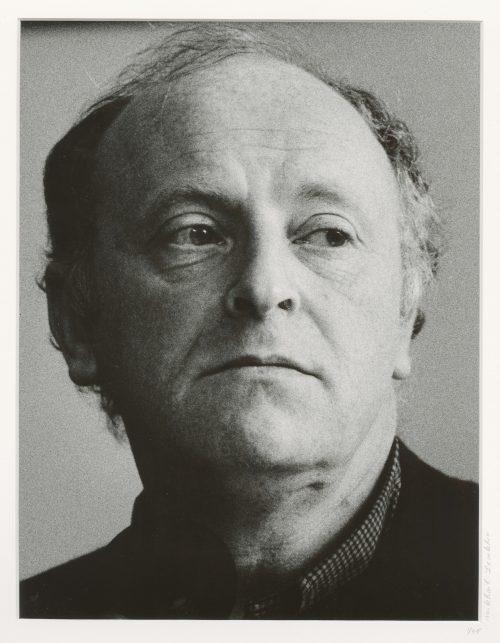 Photographic portrait of poet Joseph Brodsky, head and shoulder, turned slightly right, looking to the right. Pencil-signed on the mat: 1/45 • Mikhail Lemkhin; same inscription on the back of the print, and ink stamp ©Mikhail Lemkhin. Sitter: Joseph Brodsky [Иосиф Александрович Бродский ] (Russian-American-Jewish, 1940 – 1996). Size: mat: 51 x 40.5 cm; window: 34.5 x 27 cm; print: 35 x 28 cm.
Photographic portrait of poet Joseph Brodsky, head and shoulder, turned slightly right, looking to the right. Pencil-signed on the mat: 1/45 • Mikhail Lemkhin; same inscription on the back of the print, and ink stamp ©Mikhail Lemkhin. Sitter: Joseph Brodsky [Иосиф Александрович Бродский ] (Russian-American-Jewish, 1940 – 1996). Size: mat: 51 x 40.5 cm; window: 34.5 x 27 cm; print: 35 x 28 cm. -
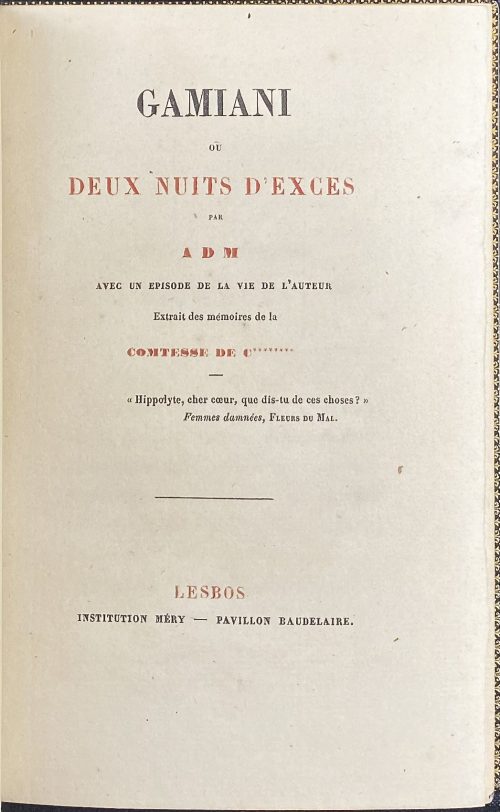 Single volume, 16.8 x 11.3 cm, bound in full dark olive crushed morocco by Brany (signed), gilt triple-fillet border to boards, spine with raised bands, gilt in compartments, gilt-lettered label, gilt dentelle inside, marbled endpapers, all margins gilt, gilt double fillet to boards margin; text printed on laid paper. Bookplate of Maurice Lebarbier de Tinan to fep 45 x 35 mm representing standing satyr with erected penis holding monogram ‘MT’ in his hands with a motto below on a ribbon ‘FAIRE SANS DIRE’. Maurice Lebarbier de Tinan book collection was dispersed via l’hôtel Drouot (Paris) on a sale from March 9 to 12, 1885; a catalogue was published: Catalogue d’un joli choix de livres anciens et modernes, en très belle condition de reliure, composant la bibliothèque de M. L. de T*** [Lebarbier de Tinan] (Paris, Ch. Porquet, 1885, in-8, VIII-140 p., 481 lots). Collation: π2 (h.t., t.p.) a6 b2 1-1112, total 82 leaves plus 18 engraved plates on wove paper; illustrations include engraved frontispiece and six etchings printed in two versions each, black and red, and one etching (at p. 103) in two states, two colour versions for each state, frontispiece and 3 or 4 plates after Félicien Rops, the others after original lithographs by Devéria and Henri Grévedon or Octave Tassaert for the 1833 edition (re-print of 1926 LIB-3135.2023). Pagination: [4] [i] ii-xvi, [3] 4-141 [3], total 164 pages, ils. Title-page (red and black): GAMIANI | OU | DEUX NUITS D’EXCES | PAR | A D M | AVEC UN EPISODE DE LA VIE DE L’AUTEUR | Extrait des mémoires de la | COMTESSE DE C******** | – | « Hippolyte, cher cœur, que dis-tu ces choses ? » | Femmes damnées, Fleurs du Mal. | — | LESBOS | INSTITUTION MERY — PAVILLON BAUDELAIRE. || Catalogue raisonné: Dutel I: A-464; Bory: 596-605; Pia: 516/7. According to Pia, the print run is limited to 150 copies on laid paper. Ref.: BNF Enfer 419. Fekete (Christie's): 135. Provenance: Maurice Lebarbier de Tinan (French, 1842 – 1918). Contributors: Alfred de Musset (French, 1810 – 1857) – author. Félicien Rops (Belgian, 1833 – 1898) – artist. Auguste Poulet-Malassis (French, 1825 – 1878) – publisher. Catalogue Poulet-Malassis & ses amis description: № 5. [Alfred de MUSSET] A D M. Gamiani ou Deux nuits d’excès, avec un épisode de la vie de l’auteur, extrait des mémoires de la comtesse de C********. Lesbos, Institution Méry, Pavillon Baudelaire [A. Poulet-Malassis, 1864]. Illustré de 8 gravures, dont l’une en frontispice, en double état (et quatre états pour la gravure « au singe » de la page 103) de Félicien Rops. Là où Baudelaire soutient Poulet-Malassis quand l’éditeur soutient l’attribution à Musset. Perfectionniste ? Trop cher ? Trop sollicité ? Pas toujours inspiré ? Rops réalisera rarement des suites complètes, ne répondant le plus souvent à la demande de ses commanditaires que par la conception de frontispices. Au verso du faux-titre, Launay voit une justification de 150 exemplaires sur papier vergé, paraphés et numérotés, qui ne figure pas ici. Très bel exemplaire relié par Brany. Provenance : Bibliothèque de Lebarbier de Tinan de Lebarbier de Tinan dont la collection fut dispersée en 1885, justifié par son ex-libris représentant un satyre en érection, portant la devise “Faire sans dire”. Bibliographie : Pia 558, Per 16-8, PC 1299, Lau 285, Enfer 419, Dutel A-464." [LIB-3118.2022]
Single volume, 16.8 x 11.3 cm, bound in full dark olive crushed morocco by Brany (signed), gilt triple-fillet border to boards, spine with raised bands, gilt in compartments, gilt-lettered label, gilt dentelle inside, marbled endpapers, all margins gilt, gilt double fillet to boards margin; text printed on laid paper. Bookplate of Maurice Lebarbier de Tinan to fep 45 x 35 mm representing standing satyr with erected penis holding monogram ‘MT’ in his hands with a motto below on a ribbon ‘FAIRE SANS DIRE’. Maurice Lebarbier de Tinan book collection was dispersed via l’hôtel Drouot (Paris) on a sale from March 9 to 12, 1885; a catalogue was published: Catalogue d’un joli choix de livres anciens et modernes, en très belle condition de reliure, composant la bibliothèque de M. L. de T*** [Lebarbier de Tinan] (Paris, Ch. Porquet, 1885, in-8, VIII-140 p., 481 lots). Collation: π2 (h.t., t.p.) a6 b2 1-1112, total 82 leaves plus 18 engraved plates on wove paper; illustrations include engraved frontispiece and six etchings printed in two versions each, black and red, and one etching (at p. 103) in two states, two colour versions for each state, frontispiece and 3 or 4 plates after Félicien Rops, the others after original lithographs by Devéria and Henri Grévedon or Octave Tassaert for the 1833 edition (re-print of 1926 LIB-3135.2023). Pagination: [4] [i] ii-xvi, [3] 4-141 [3], total 164 pages, ils. Title-page (red and black): GAMIANI | OU | DEUX NUITS D’EXCES | PAR | A D M | AVEC UN EPISODE DE LA VIE DE L’AUTEUR | Extrait des mémoires de la | COMTESSE DE C******** | – | « Hippolyte, cher cœur, que dis-tu ces choses ? » | Femmes damnées, Fleurs du Mal. | — | LESBOS | INSTITUTION MERY — PAVILLON BAUDELAIRE. || Catalogue raisonné: Dutel I: A-464; Bory: 596-605; Pia: 516/7. According to Pia, the print run is limited to 150 copies on laid paper. Ref.: BNF Enfer 419. Fekete (Christie's): 135. Provenance: Maurice Lebarbier de Tinan (French, 1842 – 1918). Contributors: Alfred de Musset (French, 1810 – 1857) – author. Félicien Rops (Belgian, 1833 – 1898) – artist. Auguste Poulet-Malassis (French, 1825 – 1878) – publisher. Catalogue Poulet-Malassis & ses amis description: № 5. [Alfred de MUSSET] A D M. Gamiani ou Deux nuits d’excès, avec un épisode de la vie de l’auteur, extrait des mémoires de la comtesse de C********. Lesbos, Institution Méry, Pavillon Baudelaire [A. Poulet-Malassis, 1864]. Illustré de 8 gravures, dont l’une en frontispice, en double état (et quatre états pour la gravure « au singe » de la page 103) de Félicien Rops. Là où Baudelaire soutient Poulet-Malassis quand l’éditeur soutient l’attribution à Musset. Perfectionniste ? Trop cher ? Trop sollicité ? Pas toujours inspiré ? Rops réalisera rarement des suites complètes, ne répondant le plus souvent à la demande de ses commanditaires que par la conception de frontispices. Au verso du faux-titre, Launay voit une justification de 150 exemplaires sur papier vergé, paraphés et numérotés, qui ne figure pas ici. Très bel exemplaire relié par Brany. Provenance : Bibliothèque de Lebarbier de Tinan de Lebarbier de Tinan dont la collection fut dispersée en 1885, justifié par son ex-libris représentant un satyre en érection, portant la devise “Faire sans dire”. Bibliographie : Pia 558, Per 16-8, PC 1299, Lau 285, Enfer 419, Dutel A-464." [LIB-3118.2022] -
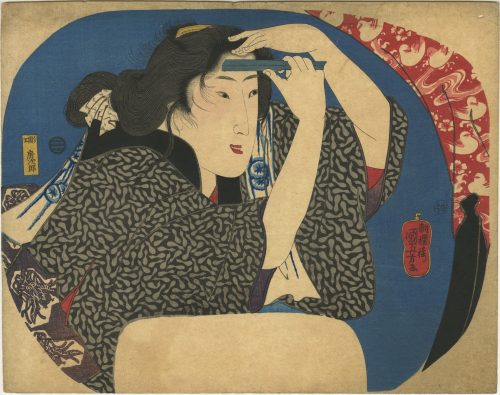 Artist: Utagawa Kuniyoshi [歌川 國芳] (Japanese, 1798 – 1861). Publisher: Ibaya Senzaburō [伊場屋仙三郎] (Japanese, fl. C. 1845 – 1847), seal: San [三] (Marks 11-001 | 127c). Carver: Matsushima Fusajirō [松嶋房次郎] (Japanese, fl. 1843 – 1850); seal [彫工房次郎] – Hori kō Fusajirō (Gordon Friese № 136) Signed: Chōōrō Kuniyoshi ga [朝櫻楼国芳画] in a red double gourd-shaped cartouche. Nanushi censor seal: Tanaka [田中]; V/1844 or II/1845. Media: Fan print (uchiwa-e, 団扇絵), 238 x 304 mm. Reference: Kuniyoshi Project. Series mentioned in Robert Schaap. Heroes and ghosts: Japanese prints by Kuniyoshi, 1797-1861.— Leiden: Hotei Publishing, 1998; p. 122 [LIB-1030.2016].
Artist: Utagawa Kuniyoshi [歌川 國芳] (Japanese, 1798 – 1861). Publisher: Ibaya Senzaburō [伊場屋仙三郎] (Japanese, fl. C. 1845 – 1847), seal: San [三] (Marks 11-001 | 127c). Carver: Matsushima Fusajirō [松嶋房次郎] (Japanese, fl. 1843 – 1850); seal [彫工房次郎] – Hori kō Fusajirō (Gordon Friese № 136) Signed: Chōōrō Kuniyoshi ga [朝櫻楼国芳画] in a red double gourd-shaped cartouche. Nanushi censor seal: Tanaka [田中]; V/1844 or II/1845. Media: Fan print (uchiwa-e, 団扇絵), 238 x 304 mm. Reference: Kuniyoshi Project. Series mentioned in Robert Schaap. Heroes and ghosts: Japanese prints by Kuniyoshi, 1797-1861.— Leiden: Hotei Publishing, 1998; p. 122 [LIB-1030.2016].
-
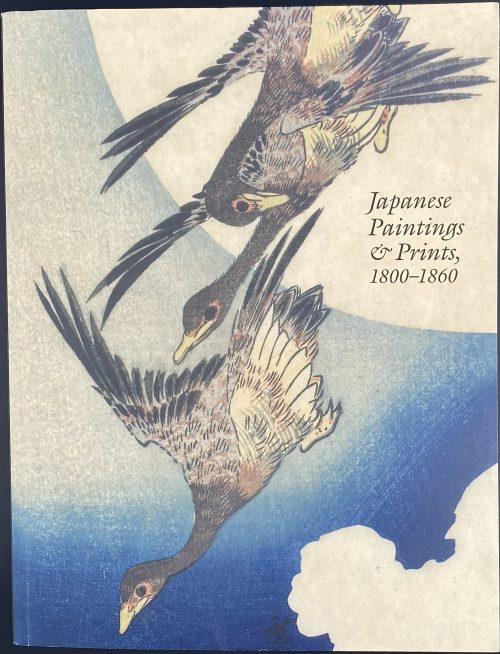 Softcover, in pictorial wrappers, 28 x 21.7 cm, 70 entries, with colour illustrations. Catalogue of the sales exhibition on March 17-24, 2023 in NY; pagination: [1-3] 4-142 [2], ils. Invitation card laid in. Contributor: Sebastian Izzard
Softcover, in pictorial wrappers, 28 x 21.7 cm, 70 entries, with colour illustrations. Catalogue of the sales exhibition on March 17-24, 2023 in NY; pagination: [1-3] 4-142 [2], ils. Invitation card laid in. Contributor: Sebastian Izzard -
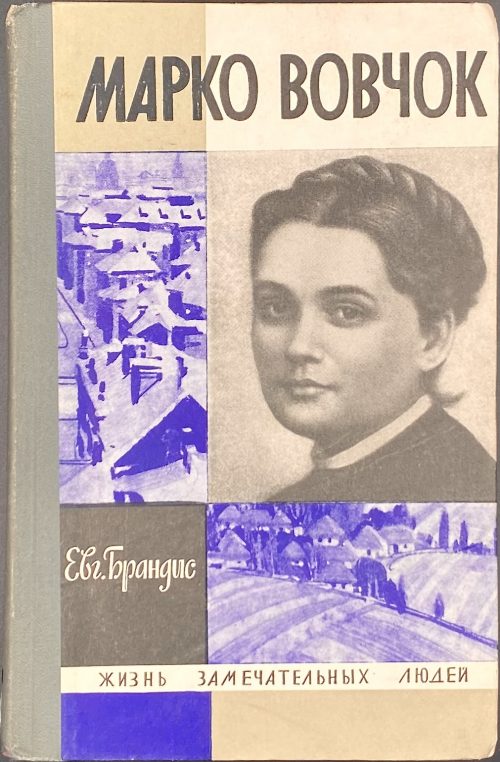 Hardcover volume, 20.8 x 13.5 cm, pictorial paper backed with grey cloth, black and white lettering to spine (serial design), pp.: [1-4] 5-333 [3]; collated 8vo: 1-218; total 168 leaves plus 13 photomechanical plates. Title-page (blue and black): Евг. Брандис | МАРКО ВОВЧОК | ИЗДАТЕЛЬСТВО | ЦК ВЛКСМ | «МОЛОДАЯ ГВАРДИЯ» | — || Frontispiece (blue and black): ЖИЗНЬ | ЗАМЕЧАТЕЛЬНЫХ | ЛЮДЕЙ | Серия биографий | ОСНОВАНА | В 1933 ГОДУ | М. ГОРЬКИМ | ВЫПУСК 19 / 460 {torch} МОСКВА / 1968 || Print-run: 100,000 copies. Contributors: Евгений Павлович Бра́ндис (Russian, 1916 – 1985) – author. Марко Вовчок [Марія Олександрівна Вілінська, Marko Vovtchok] (Ukrainian, 1833 – 1907) – character. Борис Борисович Лобач-Жученко (Russian, 1899 – 1995) – dedicatee.
Hardcover volume, 20.8 x 13.5 cm, pictorial paper backed with grey cloth, black and white lettering to spine (serial design), pp.: [1-4] 5-333 [3]; collated 8vo: 1-218; total 168 leaves plus 13 photomechanical plates. Title-page (blue and black): Евг. Брандис | МАРКО ВОВЧОК | ИЗДАТЕЛЬСТВО | ЦК ВЛКСМ | «МОЛОДАЯ ГВАРДИЯ» | — || Frontispiece (blue and black): ЖИЗНЬ | ЗАМЕЧАТЕЛЬНЫХ | ЛЮДЕЙ | Серия биографий | ОСНОВАНА | В 1933 ГОДУ | М. ГОРЬКИМ | ВЫПУСК 19 / 460 {torch} МОСКВА / 1968 || Print-run: 100,000 copies. Contributors: Евгений Павлович Бра́ндис (Russian, 1916 – 1985) – author. Марко Вовчок [Марія Олександрівна Вілінська, Marko Vovtchok] (Ukrainian, 1833 – 1907) – character. Борис Борисович Лобач-Жученко (Russian, 1899 – 1995) – dedicatee. -
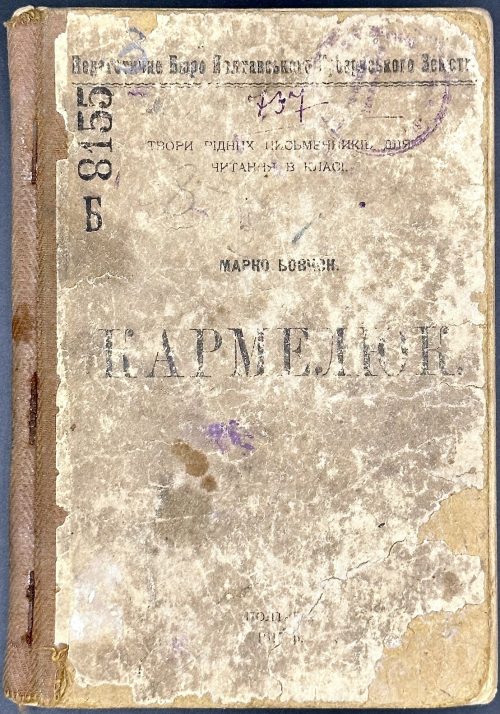 Owner’s quarter brown cloth, 18.2 x 12.5 cm, lettered paper over cardboard; text printed on tan paper, [1, 2] (t.p.), [i] ii-viii (intro.), [1] 4-48 (text); total 28 leaves; blue and red crayon marks to text; boards and pages with blue ink stamps and inscriptions. Front board: Педагогичне Бюро Полтавського Губернського Земства. | ТВОРИ РІДНИХ ПИСЬМЕННИКІВ ДЛЯ | ЧИТАННЯ В КЛАСІ.| МАРКО ВОВЧОК. | КАРМЕЛЮК. | ПОЛТАВА. | 1917 р. || Back board: Серія складається з творів: | Квітки, Вовчка, Шевченка, Куліша, | Руданського, Левицького І, Мирного, | Франка, Грінченка, Коцюбинського. | Полтава, друкарня Амчиславського. || Title-page: Педагогичне Бюро Полтавського Губернського Земства. | МАРКО ВОВЧОК. | КАРМЕЛЮК. | ПОЛТАВА. | 1917 р. || Contributors: Марко Вовчок [Marko Vovchok; Марія Олександрівна Вілінська] (Ukrainian, 1833 – 1907) – author. Other variants: Markowovzok and Marko Vovtchok. Амчиславский, М. Г. (Полтава, ул. Пушкина, 40) – printer.
Owner’s quarter brown cloth, 18.2 x 12.5 cm, lettered paper over cardboard; text printed on tan paper, [1, 2] (t.p.), [i] ii-viii (intro.), [1] 4-48 (text); total 28 leaves; blue and red crayon marks to text; boards and pages with blue ink stamps and inscriptions. Front board: Педагогичне Бюро Полтавського Губернського Земства. | ТВОРИ РІДНИХ ПИСЬМЕННИКІВ ДЛЯ | ЧИТАННЯ В КЛАСІ.| МАРКО ВОВЧОК. | КАРМЕЛЮК. | ПОЛТАВА. | 1917 р. || Back board: Серія складається з творів: | Квітки, Вовчка, Шевченка, Куліша, | Руданського, Левицького І, Мирного, | Франка, Грінченка, Коцюбинського. | Полтава, друкарня Амчиславського. || Title-page: Педагогичне Бюро Полтавського Губернського Земства. | МАРКО ВОВЧОК. | КАРМЕЛЮК. | ПОЛТАВА. | 1917 р. || Contributors: Марко Вовчок [Marko Vovchok; Марія Олександрівна Вілінська] (Ukrainian, 1833 – 1907) – author. Other variants: Markowovzok and Marko Vovtchok. Амчиславский, М. Г. (Полтава, ул. Пушкина, 40) – printer. -
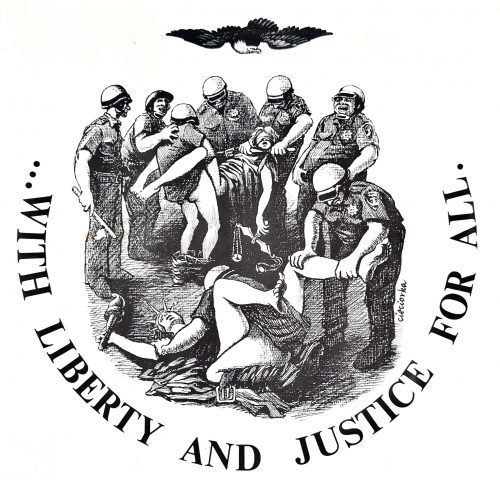 Offset lithography in back ink on paper, 448 x 448 mm, description by OMCA COLLECTIONS (Oakland Museum of California): The top edge of the poster has a stylized drawing of an eagle. Below, the poster has a drawing with eight male police officers and two female figures: one with the crown and torch of the Statue of Liberty, the other holding scales and wearing a blindfold in the style of personifications of justice. In the foreground of the drawing, one of the police officers is holding the liberty figure on the ground and raping her while a second officer holds one of her legs. In the background, the justice figure is being held up and raped by two officers. The rest of the police officers look at this scene and laugh or pat one another on the back. The bottom of the drawing is bordered by a semicircle of text that reads: "...WITH LIBERTY AND JUSTICE FOR ALL." [...] This provocative poster was described at a 1968 House Un-American Activities Committee (HUAC) hearing as "one of the most vile, obscene pieces of literature that I have seen disseminated in San Francisco" by San Francisco Examiner reporter Edward S. Montgomery. Contributors: Frank Cieciorka (American, 1939 – 2008) – artist.
Offset lithography in back ink on paper, 448 x 448 mm, description by OMCA COLLECTIONS (Oakland Museum of California): The top edge of the poster has a stylized drawing of an eagle. Below, the poster has a drawing with eight male police officers and two female figures: one with the crown and torch of the Statue of Liberty, the other holding scales and wearing a blindfold in the style of personifications of justice. In the foreground of the drawing, one of the police officers is holding the liberty figure on the ground and raping her while a second officer holds one of her legs. In the background, the justice figure is being held up and raped by two officers. The rest of the police officers look at this scene and laugh or pat one another on the back. The bottom of the drawing is bordered by a semicircle of text that reads: "...WITH LIBERTY AND JUSTICE FOR ALL." [...] This provocative poster was described at a 1968 House Un-American Activities Committee (HUAC) hearing as "one of the most vile, obscene pieces of literature that I have seen disseminated in San Francisco" by San Francisco Examiner reporter Edward S. Montgomery. Contributors: Frank Cieciorka (American, 1939 – 2008) – artist. -
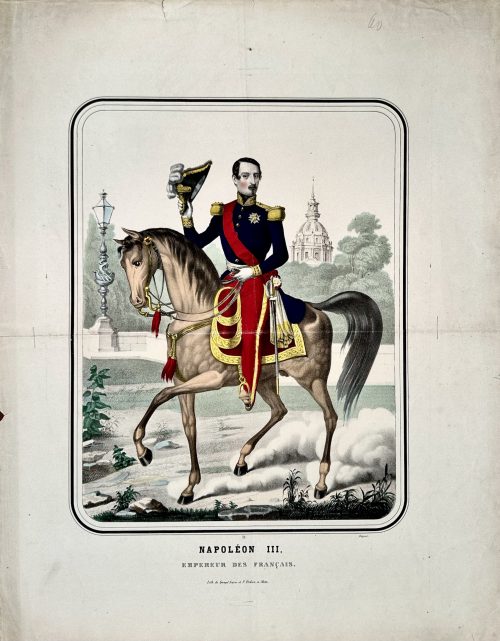 Hand-coloured chromolithography on wove paper, 600 x 470 mm; black ink stamp “4921” to reverse, horizontal and vertical centrefolds. Image of Napoléon III on horseback, in a frame; lettering under the frame: 34 — Déposé | NAPOLÉON III | EMPEREUR DES FRANÇAIS. | Lith. de Gangel frères et P. Didion, à Metz. || Gangel frères et P. Didion (Metz) – printer/publisher. Paulin Didion (French, 1831 – 1879)
Hand-coloured chromolithography on wove paper, 600 x 470 mm; black ink stamp “4921” to reverse, horizontal and vertical centrefolds. Image of Napoléon III on horseback, in a frame; lettering under the frame: 34 — Déposé | NAPOLÉON III | EMPEREUR DES FRANÇAIS. | Lith. de Gangel frères et P. Didion, à Metz. || Gangel frères et P. Didion (Metz) – printer/publisher. Paulin Didion (French, 1831 – 1879) -
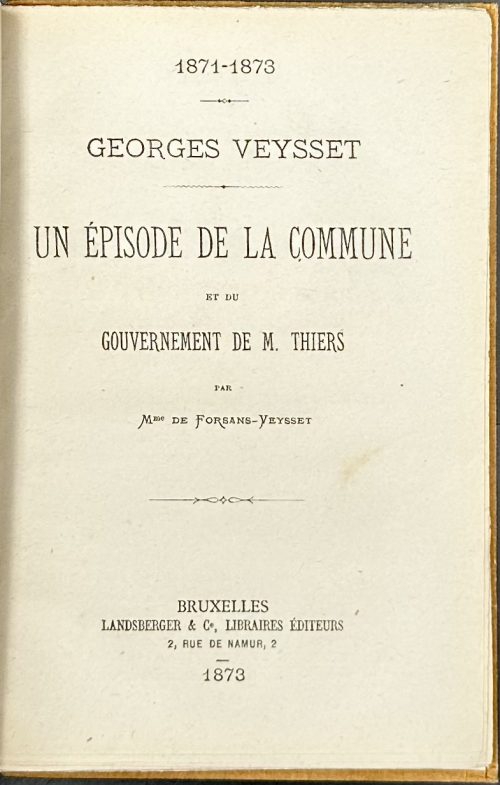 Owner’s hardcover, 182 x 120 mm, yellow buckram, crimson morocco label to spine with gilt lettering; publisher’s pink wrappers preserved, round engraved bookplate to front pastedown “DE LA BIBLIOTHÈQUE DE JULES RICHARD” cut to the border (“Imp. r. C. Motteroz” cut out); Pp.: [4] [1-5] 6-83 [84], various mss and printed clippings, 2 extra ffls to front and back. Title-page: 1871-1873 | — | GORGES VEYSSET | — | UN ÉPISODE DE LA COMMUNE | ET DU | GOUVERNEMENT DE M. THIERS | PAR | Mme DE FORSANS-YEYSSET | — | BRUXELLES | LANDSBERGER & C°, LIBRAIRES ÉDITEURS | 2, RUE DE NAMUR, 2 | 1873 || Provenance: Jules Richard (French, 1848 – 1930). Ref: BNF.
Owner’s hardcover, 182 x 120 mm, yellow buckram, crimson morocco label to spine with gilt lettering; publisher’s pink wrappers preserved, round engraved bookplate to front pastedown “DE LA BIBLIOTHÈQUE DE JULES RICHARD” cut to the border (“Imp. r. C. Motteroz” cut out); Pp.: [4] [1-5] 6-83 [84], various mss and printed clippings, 2 extra ffls to front and back. Title-page: 1871-1873 | — | GORGES VEYSSET | — | UN ÉPISODE DE LA COMMUNE | ET DU | GOUVERNEMENT DE M. THIERS | PAR | Mme DE FORSANS-YEYSSET | — | BRUXELLES | LANDSBERGER & C°, LIBRAIRES ÉDITEURS | 2, RUE DE NAMUR, 2 | 1873 || Provenance: Jules Richard (French, 1848 – 1930). Ref: BNF. -
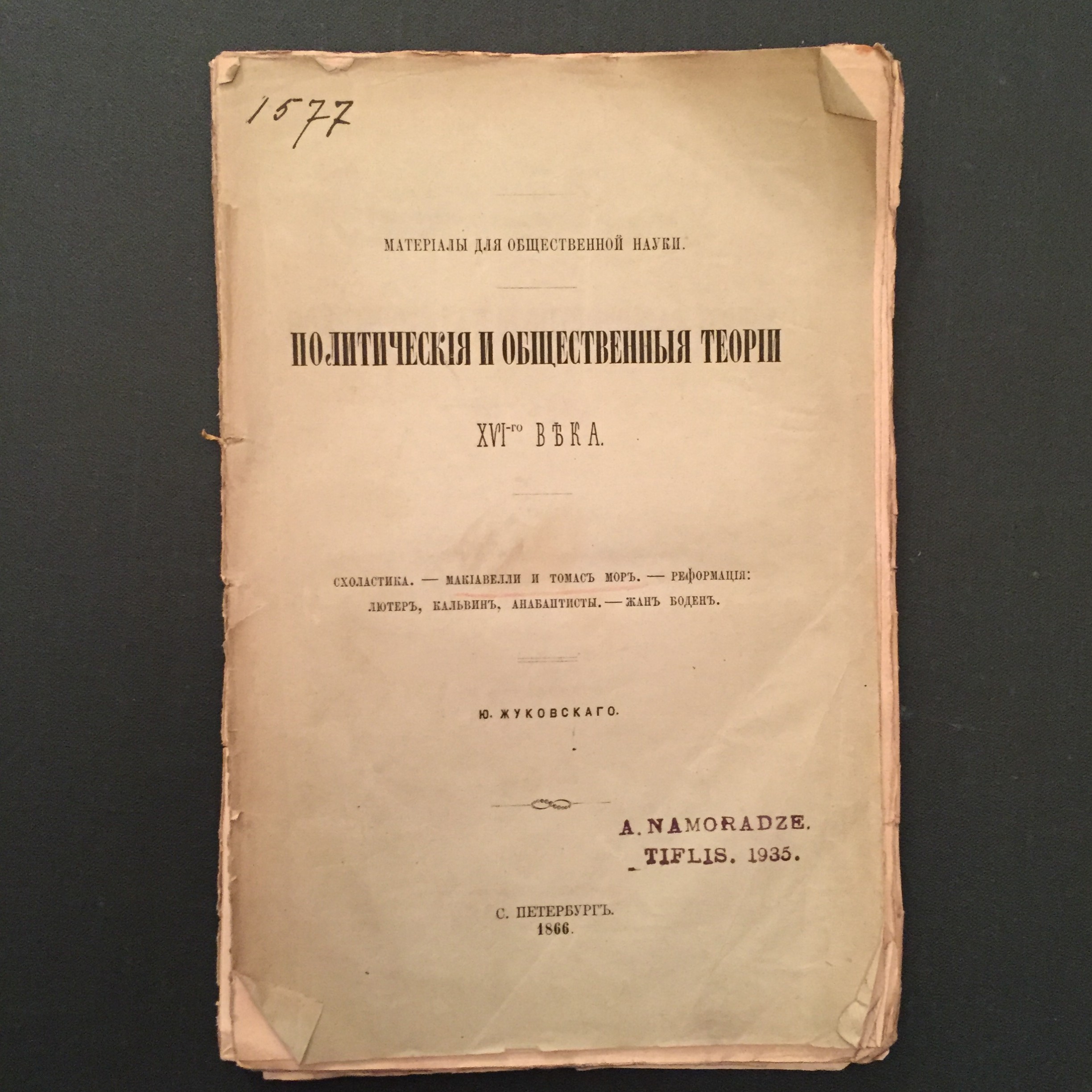
Жуковский Ю. Г. Политические и общественные теории XVI-го века. - С.Петербург, 1866. Типография А. Головачева. // Материалы для общественной науки. - 163 с.
Схоластика.
Макиавелли и Томас Мор.
Реформация: Лютер, Кальвин, анабаптисты.
Жан Боден.
[Штамп на титуле: A. Namoradze, Tiflis. 1935.]
-
 UTAGAWA TOYOKUNI I (1769–1825) Ichikawa Danjūrō VII (Ebizo V) in a shibaraku costume bursting through a paper screen. Surimono. Colour woodblock print: shikishiban, 8⅛ x 7⅛ in. (20.7 x 18.2 cm) Signed: Toyokuni ga Poem signed: Sakuragawa Jihinari Provenance: Sidney C. Ward
UTAGAWA TOYOKUNI I (1769–1825) Ichikawa Danjūrō VII (Ebizo V) in a shibaraku costume bursting through a paper screen. Surimono. Colour woodblock print: shikishiban, 8⅛ x 7⅛ in. (20.7 x 18.2 cm) Signed: Toyokuni ga Poem signed: Sakuragawa Jihinari Provenance: Sidney C. Ward -
 Iron tsuba of slightly elongated round form decorated with design of melon flowers, vines, and leaves in brass flat inlay (hira-zōgan) on both sides. Slightly raised rim (mimi) carved in a way to simulate ring-shaped covering (fukurin). Kozuka hitsu-ana and kogai hitsu-ana both plugged with soft metal (tim or lead). Copper sekigane. Heianjō or Kaga School. Muromachi or Momoyama period, 16th century. Iron, hira-zōgan brass inlay. Round (maru gata) form, diameter 79 mm. Size: 80.3 x 78.4 mm; thickness at seppa-dai: 3.4 mm; at the middle: 3.8 mm; before the rim: 2.4 mm, rim: 2.8 mm. Note on design: though this design resembles family crests with oak and mulberry leaves, I believe it's a melon flower [see Jeanne Allen. Designer's guide to Samurai Patterns. Chronicle Books, San Francisco, 1990, page 114, №130 "Melon Flowers":Note about the distribution of thickness (niku-oki): "this tsuba has toroid features, niku raises from the rim towards the centre but thins once more out when approaching the seppa-dai" [M. Sesko, "Handbook...", p. 48].
Iron tsuba of slightly elongated round form decorated with design of melon flowers, vines, and leaves in brass flat inlay (hira-zōgan) on both sides. Slightly raised rim (mimi) carved in a way to simulate ring-shaped covering (fukurin). Kozuka hitsu-ana and kogai hitsu-ana both plugged with soft metal (tim or lead). Copper sekigane. Heianjō or Kaga School. Muromachi or Momoyama period, 16th century. Iron, hira-zōgan brass inlay. Round (maru gata) form, diameter 79 mm. Size: 80.3 x 78.4 mm; thickness at seppa-dai: 3.4 mm; at the middle: 3.8 mm; before the rim: 2.4 mm, rim: 2.8 mm. Note on design: though this design resembles family crests with oak and mulberry leaves, I believe it's a melon flower [see Jeanne Allen. Designer's guide to Samurai Patterns. Chronicle Books, San Francisco, 1990, page 114, №130 "Melon Flowers":Note about the distribution of thickness (niku-oki): "this tsuba has toroid features, niku raises from the rim towards the centre but thins once more out when approaching the seppa-dai" [M. Sesko, "Handbook...", p. 48].
Jeanne Allen. Designer's guide to Samurai Patterns. Chronicle Books, San Francisco, 1990. Page 114, №130.
-
 Ōnin shinchū ten-zōgan tsuba. Iron tsuba of round form decorated with full moon and bamboo shoot (takenoko) motif executed in openwork (sukashi) and inlaid with four concentric rows of brass dots (ten-zōgan). The innermost row of dots as well as the sukashi openings outlined with the inlaid linear brass wire. Late Muromachi period, 16th century. Diameter: 82.0 mm; Thickness: 2.8 mm Cited from Merrily Baird. Symbols of Japan. Thematic motifs in art and design. Rizzoli international publications, Inc., 2001, p. 72: "In Japanese art, the appearance of bamboo shoots is often without symbolic meaning. In other cases, however, the shoots are emblematic of Moso (Chinese: Meng Tsung/Meng Zong), a paragon of filial piety who dug through snow to find shoots for his mother. ... especially in miniature art forms, let bamboo shoots alone speak for the full story." The full story is this (See THE TWENTY-FOUR PARAGONS OF FILIAL PIETY [ERSHISI XIAO]):
Ōnin shinchū ten-zōgan tsuba. Iron tsuba of round form decorated with full moon and bamboo shoot (takenoko) motif executed in openwork (sukashi) and inlaid with four concentric rows of brass dots (ten-zōgan). The innermost row of dots as well as the sukashi openings outlined with the inlaid linear brass wire. Late Muromachi period, 16th century. Diameter: 82.0 mm; Thickness: 2.8 mm Cited from Merrily Baird. Symbols of Japan. Thematic motifs in art and design. Rizzoli international publications, Inc., 2001, p. 72: "In Japanese art, the appearance of bamboo shoots is often without symbolic meaning. In other cases, however, the shoots are emblematic of Moso (Chinese: Meng Tsung/Meng Zong), a paragon of filial piety who dug through snow to find shoots for his mother. ... especially in miniature art forms, let bamboo shoots alone speak for the full story." The full story is this (See THE TWENTY-FOUR PARAGONS OF FILIAL PIETY [ERSHISI XIAO]):Tears That Brought Bamboo-shoots From the Frozen Earth: Meng Zong Meng Zong lived during the Three Kingdoms Period of China's past. His father died when he was young, and he and his mother struggled to survive. One winter his mother was stricken with a serious illness, and craved some bamboo-shoot broth as medicine. But in the depths of winter, with snow and ice blanketing the ground, where was anyone to find fresh bamboo shoots, shoots that emerge only in the warm months? Nonetheless, Meng Zong, to avoid disappointing his mother, bravely fetched his shovel and went out into the white landscape in search of bamboo shoots. In the thicket he found only frosted leaves and green stalks coated with snowflakes and ice. Look as he might, there were simply no fresh shoots growing in the winter. The thought of his poor mother lying sick on her bed, waiting for bamboo-broth medicine, made his heartache. Uncontrollably, tears began to fall in rivers to the ground beneath the tall, emerald canes. Even now, as his tears flowed down, he kept a light of faith in his heart. If he was truly sincere in his search, perhaps.... Just then Meng Zong nearly tripped and fell over a sharply protruding lump of earth. He quickly knelt down and knocked aside the dirt with his trembling fingers. How uncanny! Underneath his frozen hands he discovered a bed of fresh, tender bamboo shoots! Overjoyed, he gathered up a coatful and carried them back home. The broth that he quickly set stewing in the pot soon cured his mother's illness. The neighbors, hearing the story, exclaimed that it was the strength of his sincere, unselfish, filial resolve that inspired heaven and earth to respond, and to bring up, out of season, the fresh shoots that cured his mother's disease. Before Meng Zong's prayers generated this miracle, it was normally considered impossible for bamboo shoots to grow in the winter. After the nmiracle took place, however, people were able to gather and to eat bamboo shoots all year round. The winter variety that existed hereafter became known as "winter shoots." The villagers were deeply influenced by Meng Zong's courage and devotion. They renamed the spot where the event took place, "Meng Zong's Bamboo Grove". We can now enjoy bamboo sprouts during the winter as well, and as we do so, it is fitting to recollect Meng Zong's outstanding example of filial respect, and reflect on our conduct as sons and daughter of our parents. A verse in his honor says, His teardrops transformed winter at the roots; Up from the ice crept tender bamboo shoots. Instantly, the winter-sprouts matured; Heaven's will: a happy, peaceful world.
-
 Round iron plate of grey colour decorated in low relief (sukidashi-bori) on the face with sea waves (both layered waves, seigaiha, and rough waves, araumi), sago palm (cycas revoluta, sotetsu), presumably orchid leaves (ran) - five of them - hanging from the above, and reeds (ashi), and on the back with waves (seigaiha only), rocks, chrysanthemums (kiku), clove (chori), reed, and presumably orchid leaves - three of them - hanging from the above. The kozuka-hitsu-ana was probably cut later. The plate is lacking the raised rim, typical for the kamakura-bori school. Muromachi period. Dimensions: Height: 76.8 mm, width: 76.1 mm, Thickness at seppa-dai: 3.3 mm, at rim 2.0 mm. Height of nakago-ana: 29 mm. Weight: 82.4 g. NBTHK certificate № 402152: Hozon - "Worthy of preservation". A similar (most probably the same) tsuba is illustrated and described at Butterfield & Butterfield. IMPORTANT JAPANESE SWORDS, SWORD FITTINGS AND ARMOR. Auction Monday, November 19th, 1979. Sale # 3063 under lot № 66. It describes the piece as following: “Kamakura bori work of the Muromachi period. Round thin plate with some small iron bones in the edge. Carved with design of plants (sego palm) rocks, and waves on the face. The back has half of two chrysanthemums, waves, clove, and sego palm leaves. The kozuka-hitsu has been added and later enlarged. A good typical example without the rim most have. Diameter: 7.7 cm., thickness 2.5 mm. Estimated price $100-200":
Round iron plate of grey colour decorated in low relief (sukidashi-bori) on the face with sea waves (both layered waves, seigaiha, and rough waves, araumi), sago palm (cycas revoluta, sotetsu), presumably orchid leaves (ran) - five of them - hanging from the above, and reeds (ashi), and on the back with waves (seigaiha only), rocks, chrysanthemums (kiku), clove (chori), reed, and presumably orchid leaves - three of them - hanging from the above. The kozuka-hitsu-ana was probably cut later. The plate is lacking the raised rim, typical for the kamakura-bori school. Muromachi period. Dimensions: Height: 76.8 mm, width: 76.1 mm, Thickness at seppa-dai: 3.3 mm, at rim 2.0 mm. Height of nakago-ana: 29 mm. Weight: 82.4 g. NBTHK certificate № 402152: Hozon - "Worthy of preservation". A similar (most probably the same) tsuba is illustrated and described at Butterfield & Butterfield. IMPORTANT JAPANESE SWORDS, SWORD FITTINGS AND ARMOR. Auction Monday, November 19th, 1979. Sale # 3063 under lot № 66. It describes the piece as following: “Kamakura bori work of the Muromachi period. Round thin plate with some small iron bones in the edge. Carved with design of plants (sego palm) rocks, and waves on the face. The back has half of two chrysanthemums, waves, clove, and sego palm leaves. The kozuka-hitsu has been added and later enlarged. A good typical example without the rim most have. Diameter: 7.7 cm., thickness 2.5 mm. Estimated price $100-200":
Butterfield & Butterfield, 1979. Sale # 3063, lot № 66.
-
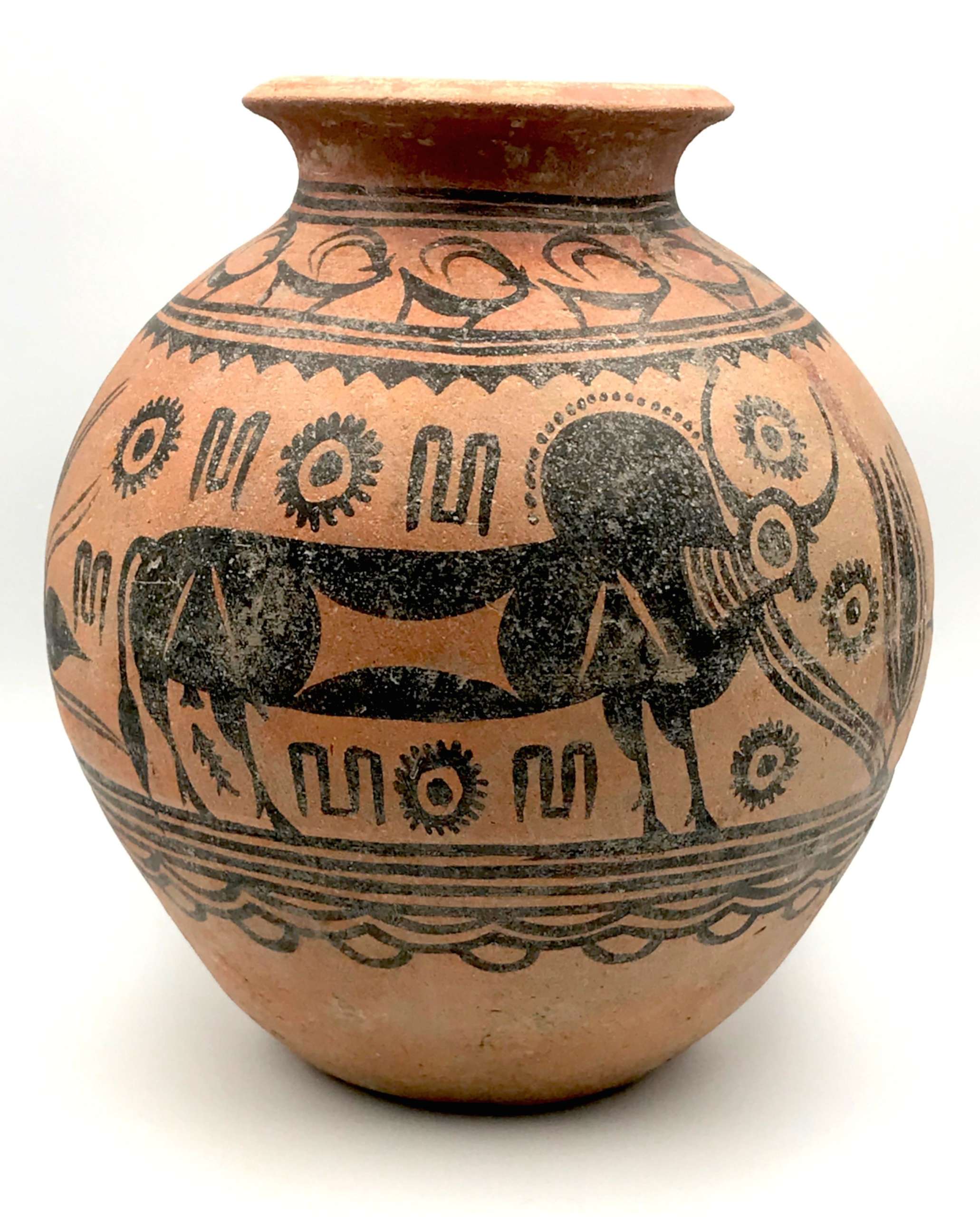 Circa 3300-2000 BC Dimensions: 184 x 165mm. Weight: 708grams
Circa 3300-2000 BC Dimensions: 184 x 165mm. Weight: 708grams -

Iron tsuba of round form with dam-shaped rim (dote-mimi) pierced with hitsu-ana and two udenuki-ana (probably cut later on) decorated in flat inlay (hira-zōgan) with vines and symbols of thunder or lightning (possibly - family crest, mon). Hitsu-ana and nakago-ana with copper sekigane.
Ōnin or Heianjō school, or, possibly Kaga or Umetada school. Momoyama period or earlier (Muromachi), 16th century. Unsigned.Size: 64.5 x 63.8 x 2.2 (center), 4.2 (rim) mm.
Provenance: Lundgren Collection: [Japanese sword-fittings and metalwork in the Lundgren Collection. Published by Otsuka Kogeisha Co., Ltd., Tokyo 1992], №31; The Lundgren Collection of Japanese Swords, Sword Fittings and A Group of Miochin School Metalwork. Christie's Auction: Tuesday, 18 November 1997, London. Sales "GOTO-5881". Christie's, 1997, №2. Lundgren's description at Christie's: Heianjo tsuba. Unsigned. The circular plate decorated in brass hirazogan with flowers, plants and symbols of thunder, dote mimi and udenuki ana, late Muromachi period (16th century). Tokyo 1992 description: Sword guard with design of flowering plants and frets in inlay. Unsigned. Heianjo inlay school. 6.35 x 6.3 cm, thickness of rim 0.40 cm. Iron. Flat brass inlay. Muromachi-Momoyama Period, 16th century. Provenance: The Second John Harding. A somewhat look-a-like pieces can be found in various catalogues. The one in Naunton Collection, №172, is signed: Umetada of Yamashiro: "Iron, small, almost circular, with raised oval rim, inlaid all over with leaves and scrolls in brass hirazōgan." -
 Iron tsuba of round form decorated with design of moon, stars, cloud, snowflake, gorintō, and Genji-mon in negative openwork (in-sukashi). Raised tubular rim (dote-mimi). Deep black patina, traces of lacquer. Naka-daka type of plate (thicker in center, getting thiner towards the rim). Visible gap between the rim and the plate. Dimensions: Height: 91.7 mm; Width: 90.8 mm; Thickness at seppa-dai: 2.5 mm, plate before rim: 2.2 mm, of the rim: 5.6 mm. At least Mid Muromachi period, 15th century, but possibly earlier. In 'Silver Book', commenting tsuba №34 Sasano writes: "The technique used to create the rim is the same used for the peak (koshimaki) of helmets (kabuto) during the Kamakura and Nanbokucho periods." On the other hand, the abundance of sukashi elements points towards later times, perhaps late Muromachi or even Momoyama period. "Gorintō is a grave stone composed of five pieces, piled on one the other, representing, from the bottom upward, earth, water, fire, wind, and heaven, respectively" [Nihon Tō Kōza, Volume VI, Part 1. AFU, 1993, p. 6. / LIB-1554]. A romantic description of the piece may look like this: The air is scented (incense symbol); it's a graveyard, marked by gorintō; a winter (snowflake) evening or night (moon, stars); mist is rising from a ravine towards moon. I did not manage to find a katchūshi piece of this design, only a few Kamakura-bori tsuba:
Iron tsuba of round form decorated with design of moon, stars, cloud, snowflake, gorintō, and Genji-mon in negative openwork (in-sukashi). Raised tubular rim (dote-mimi). Deep black patina, traces of lacquer. Naka-daka type of plate (thicker in center, getting thiner towards the rim). Visible gap between the rim and the plate. Dimensions: Height: 91.7 mm; Width: 90.8 mm; Thickness at seppa-dai: 2.5 mm, plate before rim: 2.2 mm, of the rim: 5.6 mm. At least Mid Muromachi period, 15th century, but possibly earlier. In 'Silver Book', commenting tsuba №34 Sasano writes: "The technique used to create the rim is the same used for the peak (koshimaki) of helmets (kabuto) during the Kamakura and Nanbokucho periods." On the other hand, the abundance of sukashi elements points towards later times, perhaps late Muromachi or even Momoyama period. "Gorintō is a grave stone composed of five pieces, piled on one the other, representing, from the bottom upward, earth, water, fire, wind, and heaven, respectively" [Nihon Tō Kōza, Volume VI, Part 1. AFU, 1993, p. 6. / LIB-1554]. A romantic description of the piece may look like this: The air is scented (incense symbol); it's a graveyard, marked by gorintō; a winter (snowflake) evening or night (moon, stars); mist is rising from a ravine towards moon. I did not manage to find a katchūshi piece of this design, only a few Kamakura-bori tsuba:
100 selected tsuba from European collections. Catalogue by Robert Haynes and Robert Burawoy, 1984, page 16, №5.
While the upper tsuba is dated end of Muromachi, the lower is attributed to the 17th century - Momoyama or early Edo period, though the author put this attribution under question. Deciphering of the strangely shaped opening to the left of nakago-ana is sometimes "a conventional scroll", and sometimes - a fern or bracken. I think mine is a cloud or mist, but I don't have any material evidence proving this understanding and came to conclusion by context only. It may easily be a dinosaurs playing ball. The fact that this thing always accompanies the Genji-mon, or incense symbol, it may be a scent itself.
Japanese Sword Fittings. Collection of G.H. Naunton, Esq., by Henri L. Joly, - 1912; №9.
-
 Iron tsuba of round form decorated with eight roundels – circular emblems of flowers and/or family crests (mon) made of cast brass, pierced and chiselled in kebori, and with flat brass inlay (hira-zōgan) of vines or leaves all over the plate. Both hitsu-ana trimmed with brass. Nakago-ana of trapezoidal form. A distinctive character of this tsuba is a mon at 6 hours depicting tomoe (comma). Yoshirō school (Kaga-Yoshirō). Attributed to Koike Yoshirō Naomasa himself. Unsigned. The Momoyama or early Edo period, end of the 16th to the first half of the 17th century (1574-1650). Size: Diameter 82.0 mm, thickness 3.8 mm at seppa-dai, 3.4 mm at rim.
Iron tsuba of round form decorated with eight roundels – circular emblems of flowers and/or family crests (mon) made of cast brass, pierced and chiselled in kebori, and with flat brass inlay (hira-zōgan) of vines or leaves all over the plate. Both hitsu-ana trimmed with brass. Nakago-ana of trapezoidal form. A distinctive character of this tsuba is a mon at 6 hours depicting tomoe (comma). Yoshirō school (Kaga-Yoshirō). Attributed to Koike Yoshirō Naomasa himself. Unsigned. The Momoyama or early Edo period, end of the 16th to the first half of the 17th century (1574-1650). Size: Diameter 82.0 mm, thickness 3.8 mm at seppa-dai, 3.4 mm at rim. -
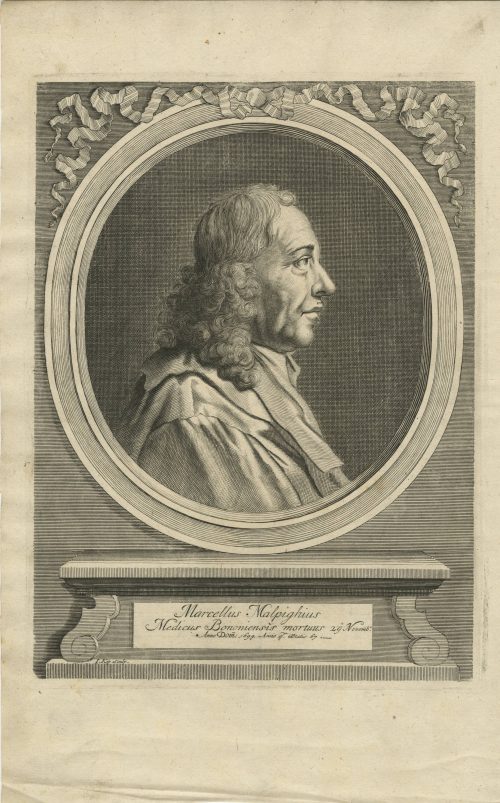
A portrait of Marcello Malpighi from his book Opera posthuma: figuris aeneis illustrata, quibus praefixa est ejusdem vita a seipso scripta, Londini:Churchill, 1697. Inscription: Marcellus Malpighius | Medicus Bononiensis mortuus 29 Novemb. Anno Dom. 1694. Anno aetatis 67. I. Kip. sculp.
Marcello Malpighi (10 March 1628 – 29 November 1694) was an Italian biologist and physician, who is referred to as the "Father of microscopical anatomy, histology, physiology and embryology" [Wikipedia].
From European Journal of Anatomy 22(5):433-439 · September 2018, an article by Sanjib Ghosh and Ashutosh Kumar 'Marcello Malpighi (1628-1694): Pioneer of microscopic anatomy and exponent of the scientific revolution of the 17th Century': Italian anatomist and an eminent scientist who significantly contributed to the advancement of the anatomical sciences in the 17th century. Malpighi was one of the first to use the compound microscope (an instrument designed by Galileo in 1609) and made the most important discovery of his life in 1661 when he identified capillaries as connecting vessels between small arteries and veins in the lungs. Malpighi thus provided the missing link in William Harvey's theory of blood circulation. He made significant contributions in the field of embryology based on his observations on chick embryo, and his efforts provided deep insights into the development of the heart and the nervous system. His communications based on microscopic studies scripted valuable details on the structural organization of organs like the liver, kidney and spleen. He identified the hepatic lobule as the fundamental unit of the liver and noted that bile was being secreted by these lobules and not from the gall bladder (the popular belief then). In the kidney, he discovered the glomerulus (Malpighian Corpuscle) and was the first to observe the convoluted tubules in the renal cortex. He was the first to describe the presence of lymphatic bodies (Malpighi's Corpuscle) in the spleen. Although he was exceedingly successful in his scientific activities, his life was fraught with unfortunate events and savage criticism from detractors arising out of professional jealousy and personal feuds. Nevertheless, his exploits were instrumental in understanding the human microscopic anatomy (histology) and his accomplishments have etched his name in the pages of medical science forever.
The portrait was engraved by Johannes "Jan" Kip (1652/53, Amsterdam – 1722, Westminster) - a Dutch draftsman, engraver and print dealer.
-
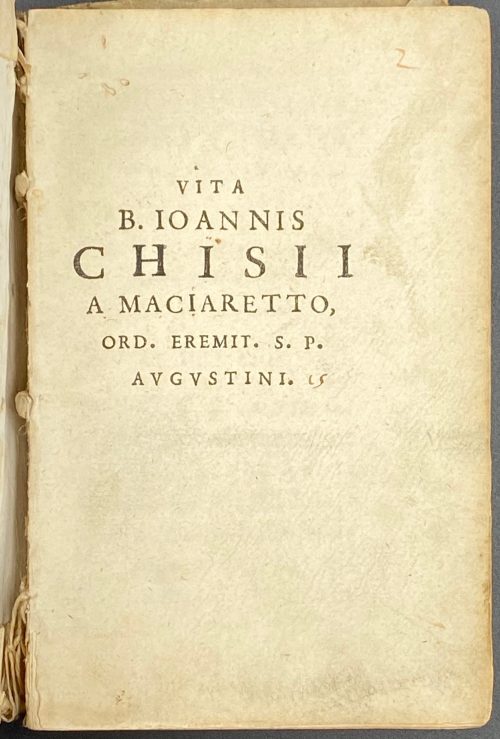 [Michael Hoyer]. Vita B. Ioannis Chisii a Maciaretto, ord. ermit. s. p. Augustini. — Antverpiæ, Apud Henricum Aertssens, Anno MDCXLI [1641]. Pagination: [2] *3+recto unpag. *4+recto unpag., [10], 5-135 [3]. Illustrations: Frontispiece missing, 4 copperplate engravings (pp. 22, 64, 90, and 120) by Pieter de Jode the Younger (1606–1674, Flemish printmaker, draughtsman, painter and art dealer) after Erasmus Quellinus the Younger (1607–1678, Flemish painter, engraver, draughtsman and tapestry designer). Size: Pott 8vo (15.5 x 10 cm), vellum binding. Expanded title: Vita Beati Ioannis Chisii, a Maciaretto, Ordinis Eremitarum Sancti Patris Augustini. [Translation: Life of Blessed Giovanni Chigi from Maciaretto, Order of Hermits of St. Augustine]. Blessed Giovanni Chigi (1300 - 1363) [1] was a lay brother of the Order of Hermits of St. Augustine. The Chigi family is a Roman princely family of Sienese extraction descended from the counts of Ardenghesca. The earliest authentic mention of them is in the 13th century, with one Alemanno, counsellor of the Republic of Siena. The Wikipedia article does not mention Giovanni Chigi, however, it states that one of the Chigi, Cardinal Fabio Chigi, was elected pope as Alexander VII at the Conclave of 1655. The book was published in 1641 with a dedication to the said Cardinal Fabio Chigi before he was elected pope. The town, Maciaretto, where Giovanni Chigi was from, is unclear because there is no such place in modern Italy, and there are two places called Macereto: (1) Macereto Alta/Basso in Perugia province and (2) Macereto in the municipality of Visso, in the province of Macerata, region Marche. I assume that our Giovanni Chigi was from the one that is closer to Siena, i.e. Macereto in Perugia province. Regarding the author. There is no author's name in the book. However, in various sources, the book is mentioned as written by Michel Hoyer, who was born in Hesdin, Flanders in 1593 and died in 1650. He pursued an ecclesiastical career and professed rhetoric at the College of Saint Pierre in Lille. He later joined the Order of Saint Augustine, in the convent of Ypres, and settled in various schools in the Netherlands. His reputation attracted many students, among them Albert Rubens (1614–1657), the eldest son of Peter Paul Rubens and Isabella Brant. Michel Hoyer wrote several books, the most known is Flammulae amoris, S.P. Augustini versibus et iconibus exornatae:
[Michael Hoyer]. Vita B. Ioannis Chisii a Maciaretto, ord. ermit. s. p. Augustini. — Antverpiæ, Apud Henricum Aertssens, Anno MDCXLI [1641]. Pagination: [2] *3+recto unpag. *4+recto unpag., [10], 5-135 [3]. Illustrations: Frontispiece missing, 4 copperplate engravings (pp. 22, 64, 90, and 120) by Pieter de Jode the Younger (1606–1674, Flemish printmaker, draughtsman, painter and art dealer) after Erasmus Quellinus the Younger (1607–1678, Flemish painter, engraver, draughtsman and tapestry designer). Size: Pott 8vo (15.5 x 10 cm), vellum binding. Expanded title: Vita Beati Ioannis Chisii, a Maciaretto, Ordinis Eremitarum Sancti Patris Augustini. [Translation: Life of Blessed Giovanni Chigi from Maciaretto, Order of Hermits of St. Augustine]. Blessed Giovanni Chigi (1300 - 1363) [1] was a lay brother of the Order of Hermits of St. Augustine. The Chigi family is a Roman princely family of Sienese extraction descended from the counts of Ardenghesca. The earliest authentic mention of them is in the 13th century, with one Alemanno, counsellor of the Republic of Siena. The Wikipedia article does not mention Giovanni Chigi, however, it states that one of the Chigi, Cardinal Fabio Chigi, was elected pope as Alexander VII at the Conclave of 1655. The book was published in 1641 with a dedication to the said Cardinal Fabio Chigi before he was elected pope. The town, Maciaretto, where Giovanni Chigi was from, is unclear because there is no such place in modern Italy, and there are two places called Macereto: (1) Macereto Alta/Basso in Perugia province and (2) Macereto in the municipality of Visso, in the province of Macerata, region Marche. I assume that our Giovanni Chigi was from the one that is closer to Siena, i.e. Macereto in Perugia province. Regarding the author. There is no author's name in the book. However, in various sources, the book is mentioned as written by Michel Hoyer, who was born in Hesdin, Flanders in 1593 and died in 1650. He pursued an ecclesiastical career and professed rhetoric at the College of Saint Pierre in Lille. He later joined the Order of Saint Augustine, in the convent of Ypres, and settled in various schools in the Netherlands. His reputation attracted many students, among them Albert Rubens (1614–1657), the eldest son of Peter Paul Rubens and Isabella Brant. Michel Hoyer wrote several books, the most known is Flammulae amoris, S.P. Augustini versibus et iconibus exornatae: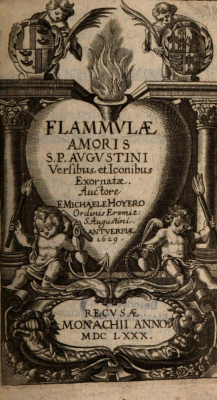 Surprisingly, there is only limited information about Michel Hoyer in Spanish Wikipedia; other language versions of his biography do not exist. Another author mentioned in the book is some anonymous Augustinian from Cologne.
Regarding the illustrations. In our copy, the frontispiece is missing. It was probably ripped off by some unscrupulous seller of antique prints.
The image on the missing frontispiece is this:
Surprisingly, there is only limited information about Michel Hoyer in Spanish Wikipedia; other language versions of his biography do not exist. Another author mentioned in the book is some anonymous Augustinian from Cologne.
Regarding the illustrations. In our copy, the frontispiece is missing. It was probably ripped off by some unscrupulous seller of antique prints.
The image on the missing frontispiece is this:
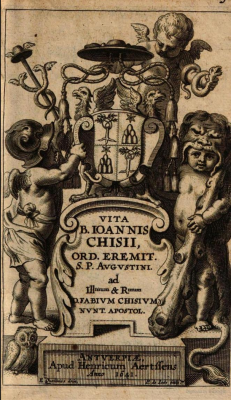 The names of the artists engraved in the bottom of the stone: E. Quellinus, delin. to the left and P. de Jode, fecit. to the right. We can infer that the other illustrations in that book are produced by the same duo. The image represents three cherubs: one with Athena's serpent in his left hand and a cardinal's hat in his right hand; another in Athen's helmet on his head and her owl beside his feet, with the staff of Mercurius (serpent-twined staff adorned with a winged hat) in his left hand, and the House of Chigi - Della Rovere coat of arms in his right hand; the third cherub depicted with the Hercules attributes - lion pelt and a club.
Regarding the publisher. Henricum Aertssens or Hendrik Aertssen, 1586-1658. Besides the other books, he published PIA DESIDERIA by Herman Hugo in 1636 [1621 french edition by Jean Cnobbartin in Antwerp in his collection LIB-1657.2018]. According to Nina Lamal [2], nothing is known about career of this publisher, besides what's said in Adresboek van zeventiende-eeuwse drukkers, uitgevers en boekverkopers in Vlaanderen / Directory of seventeenth-century Printers, Publishers and Booksellers in Flanders / Vlieger-De Wilde, Koen De (editor). The list of his publications can be seen here.
Other artists who turned to the figure of Blessed Giovanni Chigi were Abraham van Diepenbeeck (painter) and Conrad Lauwers (engraver). The print is in Rijksmuseum, in Amsterdam.
The names of the artists engraved in the bottom of the stone: E. Quellinus, delin. to the left and P. de Jode, fecit. to the right. We can infer that the other illustrations in that book are produced by the same duo. The image represents three cherubs: one with Athena's serpent in his left hand and a cardinal's hat in his right hand; another in Athen's helmet on his head and her owl beside his feet, with the staff of Mercurius (serpent-twined staff adorned with a winged hat) in his left hand, and the House of Chigi - Della Rovere coat of arms in his right hand; the third cherub depicted with the Hercules attributes - lion pelt and a club.
Regarding the publisher. Henricum Aertssens or Hendrik Aertssen, 1586-1658. Besides the other books, he published PIA DESIDERIA by Herman Hugo in 1636 [1621 french edition by Jean Cnobbartin in Antwerp in his collection LIB-1657.2018]. According to Nina Lamal [2], nothing is known about career of this publisher, besides what's said in Adresboek van zeventiende-eeuwse drukkers, uitgevers en boekverkopers in Vlaanderen / Directory of seventeenth-century Printers, Publishers and Booksellers in Flanders / Vlieger-De Wilde, Koen De (editor). The list of his publications can be seen here.
Other artists who turned to the figure of Blessed Giovanni Chigi were Abraham van Diepenbeeck (painter) and Conrad Lauwers (engraver). The print is in Rijksmuseum, in Amsterdam.
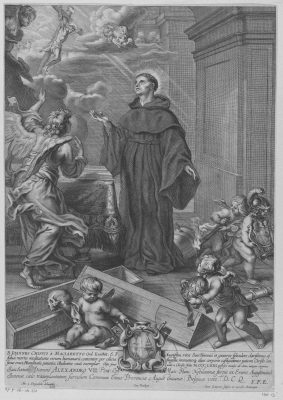 Here we see a more complex composition but with a clear reference to the work of Quellinus and de Jode: The cherub in Athena's helmet takes away the old coat of arms of the Chigi, and the other cherub points out to the new one, with papal symbols of St. Peter's keys, another cherub carries the papal tiara. Rijksmuseum dates the image as 1642 - 1685; most probably it is ca. 1655, when Fabio Chigi became Pope Alexander VII, and propaganda was focused on promoting his outstanding ancestor Giovanni, who died 300 years before. Giovanni Chigi is depicted here resurrected, accompanied by the archangel, and receiving the blessing from Jesus on the cross.
1 - Michael J. Walsh. A New Dictionary of Saints: East and West, p. 308.
2 - Nina Lamal. Publishing military books in the Low Countries and in Italy in the early seventeenth century in 'Specialist Markets in the Early Modern Book World', ed. Richard Kirwan, Sophia Mullins, Leiden: Koninklijke Brill, 2015, pp. 232-233.
Here we see a more complex composition but with a clear reference to the work of Quellinus and de Jode: The cherub in Athena's helmet takes away the old coat of arms of the Chigi, and the other cherub points out to the new one, with papal symbols of St. Peter's keys, another cherub carries the papal tiara. Rijksmuseum dates the image as 1642 - 1685; most probably it is ca. 1655, when Fabio Chigi became Pope Alexander VII, and propaganda was focused on promoting his outstanding ancestor Giovanni, who died 300 years before. Giovanni Chigi is depicted here resurrected, accompanied by the archangel, and receiving the blessing from Jesus on the cross.
1 - Michael J. Walsh. A New Dictionary of Saints: East and West, p. 308.
2 - Nina Lamal. Publishing military books in the Low Countries and in Italy in the early seventeenth century in 'Specialist Markets in the Early Modern Book World', ed. Richard Kirwan, Sophia Mullins, Leiden: Koninklijke Brill, 2015, pp. 232-233.
-
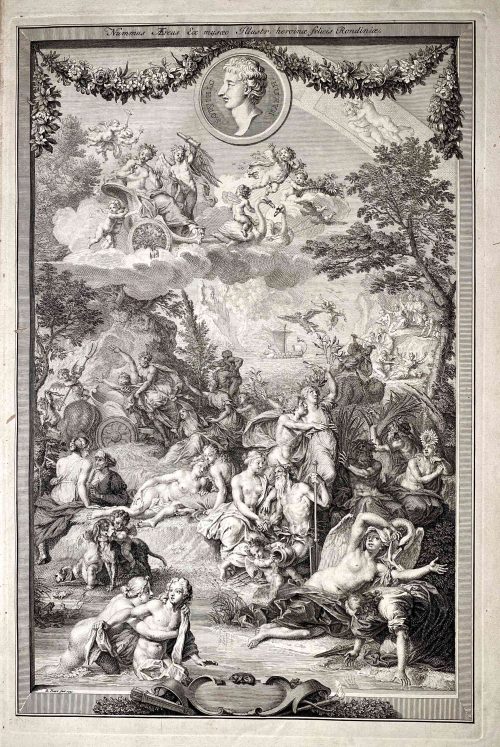 Vol. 1 title: OVID'S | METAMORPHOSES | IN LATIN AND ENGLISH, | TRANSLATED BY | THE MOST EMINENT HANDS. | With HISTORICAL EXPLICATIONS | Of the FABLES, | WRITTEN IN FRENCH BY | The ABBOT BANIER, | MEMBER OF THE ACADEMY OF INSCRIPTIONS | AND BELLES LETTRES. | TRANSLATED INTO ENGLISH. | Adorned with Sculptures, by B. Picart, and other able Masters. | VOLUME THE FIRST. | [Device] | AMSTERDAM, | Printed for the WETSTEINS and SMITH. | MD CC XXII || — Pagination: [26 – Half-title, frontis., t.p., dedic., The Bookseller's Preface To This Edition, Mr. Banier's Preface To The French Translation, Contents], [1] 2-247 – Text of books 1-7, with illus., [1 blank]. Vol. 2 half-title: OVID'S | METAMORPHOSES | IN LATIN AND ENGLISH | TWO VOLUMES || — Pagination: [2 – half-title / blank], 249-524 – Text of books 8-15, with illus., incl. 3 leaves of pl., [4 – Index]. Three leaves between pages 264 and 271 are included in the pagination as pp. [265-70] but do not carry page-numbers or letterpress text. They each carry two prints on their rectos and are blank on the verso. Vol. II without the engraved title page. The names of the translators are given in the list of Contents as Dryden, Addison, Eusden, Arthur Mainwaring, Croxall, Tate, Stonestreet, Vernon, Gay, Pope, Stephen Harvey, Congreve, Ozel, Temple Stanyan, , Catcot, Rowe, Samuel Garth, Welsted. The frontispiece is signed as made by B. Picart. The six plates on pages [265, 267, 269] are all signed as painted by C. Le Brun and engraved by Iakob Folkema. Of the 124 illustrations, most are unsigned by a draughtsman, but some are signed as designed by G. Maas, one as designed by Jul. Romain, two as designed by G. Maas and drawn by J. de Wit, one as drawn by 'HA', one as painted by C. le Brun, one as made by B. Picart, one as designed by P. Testa and drawn by B. Picart, one as designed by S. Le Clerc, one as designed by B. Picart. Many are signed by their engravers - Philip à Gunst (one as directed by B. Picart and engraved by Phil. à Gunst), J. Vandelaar (or I. Wandelaar), Martin Bouche, Jan Schenck, 'MB', Petr. Paul. Bouche, Iakob Folkema, W. Jongman, Fred. Bouttats. The title-page vignette of Volume I is signed as drawn by B. v. Overbeke and engraved by F. Mulder. Many tailpieces are signed 'VLS'. The book is dedicated by the publishers, R. and J. Wetstein and W. Smith, to the Countess of Pembroke. [Description is cited from the Royal Academy of Arts] Physical description: Two large 4to volumes, first title page printed in red and black, added engraved title in the first volume; half-title in the second volume; illustrated throughout with copperplate engravings in text; text printed in parallel columns in Latin and English; three leaves extraneous to collation each with two engravings in the second volume; bookplate pasted to the front endpaper in each volume: Ex Libris Theodore C. Tebbetts (Theodore Charles Tebbetts, American, 1871 – 1920) designed after Francis Carruthers Gould (British, 1844 – 1925); pages 517-520 of the second volume torn with loss of bottom blank corners and a word or two; original full leather, spines tooled elaborately in gilt; some boards detached, endcaps and corners rather worn, contents bright and fresh. Size: Large 4to; 47.5 x 31 cm.
Vol. 1 title: OVID'S | METAMORPHOSES | IN LATIN AND ENGLISH, | TRANSLATED BY | THE MOST EMINENT HANDS. | With HISTORICAL EXPLICATIONS | Of the FABLES, | WRITTEN IN FRENCH BY | The ABBOT BANIER, | MEMBER OF THE ACADEMY OF INSCRIPTIONS | AND BELLES LETTRES. | TRANSLATED INTO ENGLISH. | Adorned with Sculptures, by B. Picart, and other able Masters. | VOLUME THE FIRST. | [Device] | AMSTERDAM, | Printed for the WETSTEINS and SMITH. | MD CC XXII || — Pagination: [26 – Half-title, frontis., t.p., dedic., The Bookseller's Preface To This Edition, Mr. Banier's Preface To The French Translation, Contents], [1] 2-247 – Text of books 1-7, with illus., [1 blank]. Vol. 2 half-title: OVID'S | METAMORPHOSES | IN LATIN AND ENGLISH | TWO VOLUMES || — Pagination: [2 – half-title / blank], 249-524 – Text of books 8-15, with illus., incl. 3 leaves of pl., [4 – Index]. Three leaves between pages 264 and 271 are included in the pagination as pp. [265-70] but do not carry page-numbers or letterpress text. They each carry two prints on their rectos and are blank on the verso. Vol. II without the engraved title page. The names of the translators are given in the list of Contents as Dryden, Addison, Eusden, Arthur Mainwaring, Croxall, Tate, Stonestreet, Vernon, Gay, Pope, Stephen Harvey, Congreve, Ozel, Temple Stanyan, , Catcot, Rowe, Samuel Garth, Welsted. The frontispiece is signed as made by B. Picart. The six plates on pages [265, 267, 269] are all signed as painted by C. Le Brun and engraved by Iakob Folkema. Of the 124 illustrations, most are unsigned by a draughtsman, but some are signed as designed by G. Maas, one as designed by Jul. Romain, two as designed by G. Maas and drawn by J. de Wit, one as drawn by 'HA', one as painted by C. le Brun, one as made by B. Picart, one as designed by P. Testa and drawn by B. Picart, one as designed by S. Le Clerc, one as designed by B. Picart. Many are signed by their engravers - Philip à Gunst (one as directed by B. Picart and engraved by Phil. à Gunst), J. Vandelaar (or I. Wandelaar), Martin Bouche, Jan Schenck, 'MB', Petr. Paul. Bouche, Iakob Folkema, W. Jongman, Fred. Bouttats. The title-page vignette of Volume I is signed as drawn by B. v. Overbeke and engraved by F. Mulder. Many tailpieces are signed 'VLS'. The book is dedicated by the publishers, R. and J. Wetstein and W. Smith, to the Countess of Pembroke. [Description is cited from the Royal Academy of Arts] Physical description: Two large 4to volumes, first title page printed in red and black, added engraved title in the first volume; half-title in the second volume; illustrated throughout with copperplate engravings in text; text printed in parallel columns in Latin and English; three leaves extraneous to collation each with two engravings in the second volume; bookplate pasted to the front endpaper in each volume: Ex Libris Theodore C. Tebbetts (Theodore Charles Tebbetts, American, 1871 – 1920) designed after Francis Carruthers Gould (British, 1844 – 1925); pages 517-520 of the second volume torn with loss of bottom blank corners and a word or two; original full leather, spines tooled elaborately in gilt; some boards detached, endcaps and corners rather worn, contents bright and fresh. Size: Large 4to; 47.5 x 31 cm. -
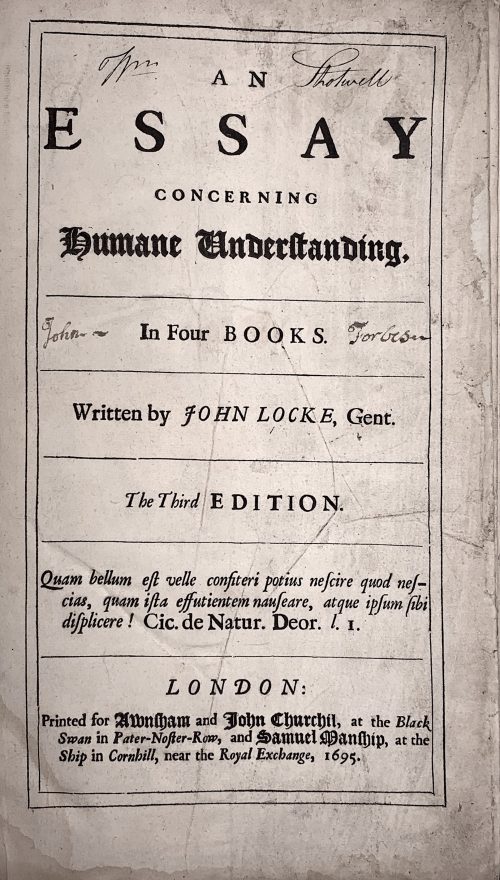 Title: AN | ESSAY | CONCERNING | HUMANE UNDERSTANDING, |—| In Four BOOKS. |—| Written by JOHN LOCKE, Gent. |—| The Third EDITION. |—| Quam bellum est velle confiteri potius nescire quod nes- | cias, quam ista effutientem nauseare, atque ipsum sibi | displicere! Cic. De Natur. Deor. l. I. |—| LONDON: | Printed for Awnsham and John Churchil, at the Black | Swan in Pater-Noster-Row, and Samuel Manship, at the | Ship in Cornhill, near the Royal Exchange, 1695. Collation: [π2]-b6, a-c4, B-Z4 Aa-Zz4 Aaa-Fff4 Ggg-Iii2 Pagination: [40] 1-407 [13]. Catalogue raisoné: The works of John Locke; a comprehensive bibliography from the seventeenth century to the present. Compiled by John C. Attig. Series: Bibliographies and Indexes in Philosophy, Number 1. Greenwood Press, Westport, CT & London, England, 1985. p. 42, №230 provides for pagination [40] 407, [13]p. Page by page reprint of 1694 edition. Regarding the epigraph on t.p.: The correct citation from , De Natura Deorum: "Quam bellum erat, Vellei, confiteri potius nescire, quod nescires, quam ista effutientem nauseare atque ipsum sibi displicere." [How delightful it would be, Velleius, if when you did not know a thing you would admit your ignorance, instead of uttering this drivel, which must make even your own gorge rise with disgust!] This life-time edition was presented as a gift to Dr Elisha Atkins (1949 – 2019), professor at Yale University School of Medicine, on July 1st, 1967, by his students, namely Carolyn Wells [Bush] (1923 – 2013), John Mooney (now a psychiatrist in Boston), and Charles Dinarello. Size: 32 x 23 cm Binding: Fill modern morocco, panelled and ruled gilt, raised bands, gilt in compartments, red label with gilt lettering; in a slipcase.
Title: AN | ESSAY | CONCERNING | HUMANE UNDERSTANDING, |—| In Four BOOKS. |—| Written by JOHN LOCKE, Gent. |—| The Third EDITION. |—| Quam bellum est velle confiteri potius nescire quod nes- | cias, quam ista effutientem nauseare, atque ipsum sibi | displicere! Cic. De Natur. Deor. l. I. |—| LONDON: | Printed for Awnsham and John Churchil, at the Black | Swan in Pater-Noster-Row, and Samuel Manship, at the | Ship in Cornhill, near the Royal Exchange, 1695. Collation: [π2]-b6, a-c4, B-Z4 Aa-Zz4 Aaa-Fff4 Ggg-Iii2 Pagination: [40] 1-407 [13]. Catalogue raisoné: The works of John Locke; a comprehensive bibliography from the seventeenth century to the present. Compiled by John C. Attig. Series: Bibliographies and Indexes in Philosophy, Number 1. Greenwood Press, Westport, CT & London, England, 1985. p. 42, №230 provides for pagination [40] 407, [13]p. Page by page reprint of 1694 edition. Regarding the epigraph on t.p.: The correct citation from , De Natura Deorum: "Quam bellum erat, Vellei, confiteri potius nescire, quod nescires, quam ista effutientem nauseare atque ipsum sibi displicere." [How delightful it would be, Velleius, if when you did not know a thing you would admit your ignorance, instead of uttering this drivel, which must make even your own gorge rise with disgust!] This life-time edition was presented as a gift to Dr Elisha Atkins (1949 – 2019), professor at Yale University School of Medicine, on July 1st, 1967, by his students, namely Carolyn Wells [Bush] (1923 – 2013), John Mooney (now a psychiatrist in Boston), and Charles Dinarello. Size: 32 x 23 cm Binding: Fill modern morocco, panelled and ruled gilt, raised bands, gilt in compartments, red label with gilt lettering; in a slipcase.


